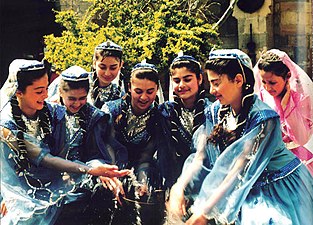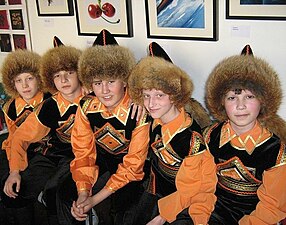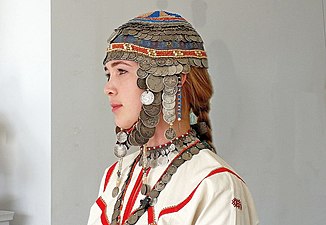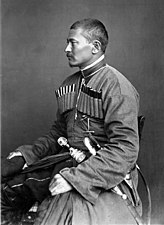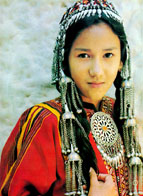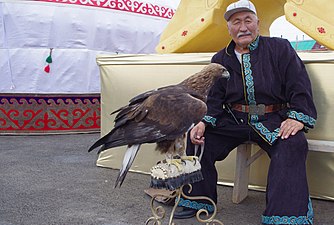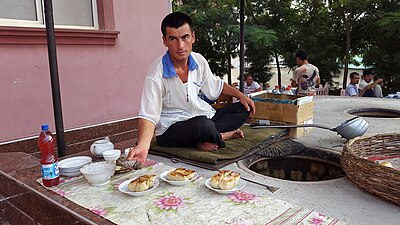Turkic peoples
TheTurkic peoplesare a collection of diverseethnic groupsofWest,Central,East,andNorth Asiaas well as parts ofEurope,who speakTurkic languages.[37][38]
According to historians and linguists, theProto-Turkic languageoriginated in Central-East Asia,[39]potentially inAltai-Sayan region,MongoliaorTuva.[40][41][42]Initially, Proto-Turkic speakers were potentially both hunter-gatherers and farmers; they later becamenomadicpastoralists.[43]Early andmedievalTurkic groups exhibited a wide range of both East Asian and West-Eurasian physical appearances and genetic origins, in part through long-term contact with neighboring peoples such asIranic,Mongolic,Tocharian,UralicandYeniseianpeoples.[44]
Many vastly differingethnic groupshave throughout history become part of the Turkic peoples throughlanguage shift,acculturation,conquest,intermi xing,adoption,andreligious conversion.[1]Nevertheless, Turkic peoples share, to varying degrees, non-linguistic characteristics like cultural traits, ancestry from a commongene pool,and historical experiences.[1]Some of the most notable modern Turkic ethnic groups include theAltai people,Azerbaijanis,Chuvash people,Gagauz people,Kazakhs,Kyrgyz people,Turkmens,Turkish people,Tuvans,Uyghurs,Uzbeks,andYakuts.
Etymology


The first known mention of the termTurk(Old Turkic:𐱅𐰇𐰼𐰰Türükor 𐱅𐰇𐰼𐰰:𐰜𐰇𐰛Kök Türük,Chinese:Đột Quyết,Pinyin:Tūjué <Middle Chinese*tɦut-kyat< *dwət-kuɑt,Old Tibetan:drugu)[45][46][47][48]applied to only one Turkic group, namely, theGöktürks,[49]who were also mentioned, astürüg~török,in the 6th-centuryKhüis Tolgoi inscription,most likely not later than 587 AD.[50][51][52]A letter byIshbara QaghantoEmperor Wen of Suiin 585 described him as "the Great Turk Khan".[53][54]TheBugut(584 CE) andOrkhon inscriptions(735 CE) use the termsTürküt,TürkandTürük.[55]
During the first century CE,Pomponius Melarefers to theTurcaein the forests north of theSea of Azov,andPliny the Elderlists theTyrcaeamong the people of the same area.[56][57][58]However, English archaeologistEllis Minnscontended thatTyrcaeΤῦρκαι is "a false correction" forIyrcaeἹύρκαι, a people who dwelt beyond theThyssagetae,according toHerodotus(Histories,iv. 22), and were likelyUgricancestors ofMagyars.[59]There are references to certain groups in antiquity whose names might have been foreign transcriptions ofTür(ü)k,such asTogarma,Turukha/Turuška,Turukkuand so on; but the information gap is so substantial that any connection of these ancient people to the modern Turks is not possible.[60][61]
The ChineseBook of Zhou(7th century) presents an etymology of the nameTurkas derived from 'helmet', explaining that this name comes from the shape of a mountain where they worked in theAltai Mountains.[62]Hungarian scholarAndrás Róna-Tas(1991) pointed to a Khotanese-Saka word,tturakä'lid', semantically stretchable to 'helmet', as a possible source for this folk etymology, yet Golden thinks this connection requires more data.[63]
It is generally accepted that the nameTürkis ultimately derived from theOld-Turkicmigration-term[64]𐱅𐰇𐰼𐰰Türük/Törük,[65]which means 'created, born'[66]or 'strong'.[67]Turkologist Peter B. Golden agrees that the termTurkhas roots inOld Turkic,[68]yet is not convinced by attempts to linkDili,Dingling,Chile,Tele,andTiele,which possibly transcribed *tegrek(probably meaning 'cart'), toTujue,which transliterated toTürküt.[69]
Scholars, including Toru Haneda, Onogawa Hidemi, and Geng Shimin believed thatDi,Dili,Dingling,ChileandTujueall came from the Turkic wordTürk,which means 'powerful' and 'strength', and its plural form isTürküt.[70]Even thoughGerhard Doerfersupports the proposal thattürkmeans 'strong' in general,Gerard Clausonpoints out that "the wordtürkis never used in the generalized sense of 'strong' "and thattürkwas originally a noun and meant "'the culminating point of maturity' (of a fruit, human being, etc.), but more often used as an [adjective] meaning (of a fruit) 'just fully ripe'; (of a human being) 'in the prime of life, young, and vigorous'".[71]Hakan Aydemir (2022) also contends thatTürkoriginally did not mean "strong, powerful" but "gathered; united, allied, confederated" and was derived from Pre-Proto-Turkicverb *türü"heap up, collect, gather, assemble".[72]
The earliest Turkic-speaking peoples identifiable in Chinese sources are theYenisei KyrgyzandXinli,located in South Siberia.[73][74][note 2]Another example of an early Turkic population would be theDingling.[79][80][81]
In Late Antiquity itself, as well as in and theMiddle Ages,the name "Scythians" was used inGreco-RomanandByzantineliterature for various groups of nomadic "barbarians"living on the Pontic-Caspian Steppe who were not related to the actual Scythians.[82][83]Medieval European chroniclers subsumed various Turkic peoples of the Eurasian steppe as "Scythians". Between 400 CE and the 16th century, Byzantine sources use the name Σκύθαι (Skuthai) in reference to twelve different Turkic peoples.[84]
In the modern Turkish language as used in the Republic of Turkey, a distinction is made between "Turks" and the "Turkic peoples" in loosely speaking: the termTürkcorresponds specifically to the "Turkish-speaking" people (in this context, "Turkish-speaking" is considered the same as "Turkic-speaking" ), while the termTürkirefers generally to the people of modern "Turkic Republics" (Türki CumhuriyetlerorTürk Cumhuriyetleri). However, the proper usage of the term is based onthe linguistic classificationin order to avoid anypoliticalsense. In short, the termTürkican be used forTürkor vice versa.[85]
List of ethnic groups
- Historical Turkic groups
- Az
- Dingling
- Bulgars
- Esegel
- Barsils
- Alat
- Basmyl
- Onogurs
- Saragurs
- Sabirs
- Shatuo
- Ongud(from Shatuo)
- Göktürks
- Oghuz Turks
- Kanglys
- Khazars
- Kipchaks
- Kurykans
- Kumans
- Pechenegs
- Karluks
- Tiele
- Turgesh
- Tukhsi
- Yenisei Kirghiz
- Chigils
- Toquz Oghuz
- Orkhon Uyghurs
- Yagma
- Nushibi
- Duolu
- Kutrigurs
- Utigurs
- Yabaku
- Yueban[note 3]
- Bulaqs
- Xueyantuo
- Torks
- Chorni Klobuky
- Berendei
- Yemeks
- Karamanlides(partly)[86][87]
- Naimans(partly)
- Keraites(partly)
- Merkits(partly)[note 4]
- Uriankhai(partly)[note 5]
Possible Proto-Turkic ancestry, at least partial,[88][89][90][91][92][93]has been posited forXiongnu,HunsandPannonian Avars,as well asTuobaandRouran,who were ofProto-MongolicDonghuancestry.[94][95][96][97]as well asTatars,Rourans' supposed descendants.[98][99][note 6]
Remarks
- ^Figure combines population of Turkmen and Uzbeks only. Population estimates of Turkmenistan's minority groups often widely vary. Some sources have cast doubt on the reliability of official government data for minority population figures.[17][18]
- ^The Xueyantuo were first known asXinliTân lê, laterXueTiết in the 7th century;[75][76]the Yenisei Kyrgyz were first known asGekun( cách côn ) orJiankun( kiên côn ), later known asJiegu( kết cốt ),Hegu( hột cốt ),Hegusi( hột thiên tư ),Hejiasi( hột kiết tư ),Hugu( hộ cốt ),Qigu( khế cốt ),Juwu( cư chớ ), andXiajiasi( hiệt kiết tư ), all being transcriptions ofKyrgyz.[77][78]
- ^Book of Weivol. 102.quote: "Duyệt quốc [...] này phong tục ngôn ngữ cùng cao xe cùng" translation: "Yueban nation [...] Their customs and language are the same as the Gaoche['s]"; Gaoche ( cao xe; lit. "High-Carts" ) was another name of the Turkic-speaking Tiele
- ^Merkits were always counted as a part of the Mongols within the Mongol Empire, however, some scholars proposed additional Turkic ancestry for Merkits; Christopher P. Atwood –Encyclopedia of Mongolia and the Mongol EmpireISBN978-0-8160-4671-3,Facts on File, Inc. 2004.
- ^Refers to forest peoples of the North, including the Turkic-speakingTuvansandYakuts,and also Mongolic-speakingAltai Uriankhai.The ethnonym Uriankhai is etymologically Mongolic, compareKhalkhauria(n)"war motto" andkhai,alternationofkhan.Uriankhai people are possibly linked to the Wuluohun tribe of theShiwei people,who were predominantly Mongolic-speaking.
- ^Even though Chinese historians routinely ascribed Xiongnu origin to various nomadic peoples, such ascriptions do not necessarily indicate the subjects' exact origins; for examples, Xiongnu ancestry was ascribed to Turkic-speaking Göktürks and Tiele as well as Para-Mongolic-speaking Kumo Xi and Khitan.[100]
Language
Distribution
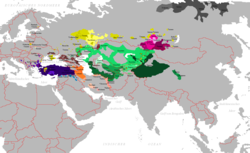
The Turkic languages constitute alanguage familyof some 30 languages, spoken across a vast area fromEastern Europeand theMediterranean,toSiberiaandManchuriaand through to the Middle East. Some 170 million people have a Turkic language as their native language;[101]an additional 20 million people speak a Turkic language as asecond language.The Turkic language with the greatest number of speakers isTurkish proper,orAnatolianTurkish, the speakers of which account for about 40% of all Turkic speakers.[102]More than one third of these are ethnicTurks of Turkey,dwelling predominantly in Turkey proper and formerlyOttoman-dominated areas of Southern and Eastern Europe andWest Asia;as well as in Western Europe, Australia and the Americas as a result of immigration. The remainder of the Turkic people are concentrated in Central Asia, Russia, theCaucasus,China, and northern Iraq.
The Turkic language family was traditionally considered to be part of the proposedAltaic language family.[103]Howeover since the 1950s, a majority of linguists have rejected the proposal, after supposedcognateswere found not to be valid, hypothesized sound shifts were not found, and Turkic andMongolic languageswere found to be converging rather than diverging over the centuries. Opponents of the theory proposed that the similarities are due tomutual linguistic influencesbetween the groups concerned.[104][105][106][107][108]
Alphabet

The Turkic Alpha bets are sets of related Alpha bets with letters (formerly known asrunes), used for writing mostlyTurkic languages.Inscriptions in Turkic Alpha bets were found inMongolia.Most of the preserved inscriptions were dated to between 8th and 10th centuries CE.
The earliest positively dated and read Turkic inscriptions date from the 8th century, and the Alpha bets were generally replaced by theOld Uyghur Alpha betin theEastandCentral Asia,Arabic script in the Middle and Western Asia,Cyrillicin Eastern Europe and in the Balkans, andLatin Alpha betin Central Europe. The latest recorded use ofTurkic Alpha betwas recorded in Central Europe's Hungary in 1699 CE.
The Turkicruniformscripts, unlike other typologically close scripts of the world, do not have a uniformpalaeographyas do, for example, theGothicruniform scripts, noted for their exceptional uniformity of language and paleography.[109]The Turkic Alpha bets are divided into four groups, the best known of which is theOrkhonversion of the Enisei group. The Orkhon script is the Alpha bet used by theGöktürksfrom the 8th century to record theOld Turkic language.It was later used by theUyghur Empire;aYeniseivariant is known from 9th-centuryKyrgyzinscriptions, and it has likely cousins in theTalas ValleyofTurkestanand theOld Hungarian scriptof the 10th century.Irk Bitigis the only known complete manuscript text written in the Old Turkic script.[110]
History
| History of the Turkic peoplespre–14th century |
|---|
 |
Origins
The origins of the Turkic peoples has been a topic of much discussion.[111][112]Peter Benjamin Goldenproposes two locations for the Proto-Turkic Urheimat: the southernAltai-Sayanregion,[40]and in SouthernSiberia,fromLake Baikalto easternMongolia.[113]Other studies suggested an early presence of Turkic peoples in Mongolia,[114][41]orTuva.[42]
A possible genealogical link of the Turkic languages to Mongolic and Tungusic languages, specifically a hypothetical homeland inManchuria,such as proposed in theTranseurasian hypothesis,byMartine Robbeets,has received support but also criticism, with opponents attributing similarities to long-term contact.[115][116][117]The proto-Turkic-speakers may be linked toNeolithicEast Asianagricultural societies inNortheastern China,which is to be associated with theXinglongwa cultureand the succeedingHongshan culture,based on varying degrees of specific East Asian genetic substratum among modern Turkic speakers.[118][119][120]According to historians, "the Proto-Turkic subsistence strategy included an agricultural component, a tradition that ultimately went back to the origin of millet agriculture in Northeast China".[118][119][120]This view is however questioned by other geneticists, who found no evidence for a shared "Neolithic Hongshan ancestry", but in contrary primaryAncient Northeast Asian(ANA) Neolithic ancestry from theAmur region,supporting an origin from Northeast Asia rather than Manchuria.[121]
Around 2,200 BC, the (agricultural) ancestors of the Turkic peoples probably migrated westwards intoMongolia,where they adopted a pastoral lifestyle, in part borrowed fromIranian peoples.Given nomadic peoples such asXiongnu,RouranandXianbeishare underlying genetic ancestry "that falls into or close to the northeast Asian gene pool", the proto-Turkic language likely originated in northeastern Asia.[123]
Genetic data found that almost all modern Turkic peoples retained at least some shared ancestry associated with populations in "South Siberia and Mongolia" (SSM), supporting this region as the "Inner Asian Homeland (IAH) of the pioneer carriers of Turkic languages" which subsequently expanded into Central Asia. The mainTurkic expansiontook place during the 5th–16th centuries, partially overlapping with theMongol Empireperiod. Based on single-path IBD tracts, the common Turkic ancestral population lived prior to these migration events, and likely stem from a similar source population asMongolic peoplesfurther East. Historical data suggests that the Mongol Empire period acted as secondary force of "turkification", as the Mongol conquest "did not involve massive re-settlements of Mongols over the conquered territories. Instead, the Mongol war machine was progressively augmented by various Turkic tribes as they expanded, and in this way Turkic peoples eventually reinforced their expansion over the Eurasian steppe and beyond."[112]

A 2018autosomalsingle-nucleotide polymorphismstudy suggested that theEurasian Steppeslowly transitioned fromIndo EuropeanandIranian-speaking groups with largely western Eurasian ancestry to increasing East Asian ancestry with Turkic and Mongolian groups in the past 4000 years, including extensive Turkic migrations out of Mongolia and slow assimilation of local populations.[124][120]A 2022 suggested that Turkic and Mongolic populations in Central Asia formed via admixture events during the Iron Age between "localIndo-Iranianand a South-Siberian or Mongolian group with a high East-Asian ancestry (around 60%). "Modern dayTurkmensform an outlier among Central Asian Turkic-speakers with a lower frequency of the Baikal component (c. 22%) and a lack of the Han-like component, being closer to other Indo-Iranian groups.[125]A subsequent study in 2022 also found that the spread of Turkic-speaking populations into Central Asia happened after the spread of Indo-European speakers into the area.[126]Another 2022 study found that all Altaic‐speaking (Turkic, Tungusic, and Mongolic) populations "were a mixture of dominant Siberian Neolithic ancestry and non-negligible YRB ancestry", suggesting their origins were somewhere in Northeast Asia, most likely theAmur river basin.Except Eastern and Southern Mongolic-speakers, all "possessed a high proportion of West Eurasian-related ancestry, in accordance with the linguistically documented language borrowing in Turkic languages".[121]
A 2023 study analyzed the DNA ofEmpress Ashina(568–578 AD), a Royal Göktürk, whose remains were recovered from a mausoleum inXianyang,China.[127]The authors determined that Empress Ashina belonged to the North-East AsianmtDNAhaplogroupF1d,and that approximately 96-98% of her autosomal ancestry was ofAncient Northeast Asianorigin, while roughly 2-4% was of West Eurasian origin, indicating ancient admixture.[127]This study weakened the "western Eurasian origin and multiple origin hypotheses".[127]However, they also noted that "Central Steppe and early Medieval Türk exhibited a high but variable degree of West Eurasian ancestry, indicating there was a genetic substructure of the Türkic empire."[127]The early medieval Türk samples were modelled as having 37.8% West Eurasian ancestry and 62.2% Ancient Northeast Asian ancestry[128]and historic Central Steppe Türk samples were also an admixture of West Eurasian and Ancient Northeast Asian ancestry,[129]while historic Karakhanid, Kipchak and the Turkic Karluk samples had 50.6%-61.1% West Eurasian ancestry and 38.9%–49.4% Iron AgeYellow Riverfarmer ancestry.[130]A 2020 study also found "high genetic heterogeneity and diversity during the Türkic and Uyghur periods" in the early medieval period inEastern Eurasian Steppe.[131]
Early historical attestation
The earliest separate Turkic peoples, such as theGekun( cách côn ) andXinli( tân lê ), appeared on the peripheries of the lateXiongnuconfederation about 200 BCE[132][133](contemporaneous with the ChineseHan Dynasty)[134]and later among the Turkic-speakingTiele[135]asHegu( hột cốt )[136]andXue( Tiết ).[75][76]
TheTiele(also known as Gaoche cao xe, lit. "High Carts" ),[137]may be related to theXiongnuand theDingling.[138]According to theBook of Wei,the Tiele people were the remnants of the Chidi ( xích địch ), the redDipeople competing with theJinin theSpring and Autumn period.[139]Historically they were established after the 6th century BCE.[133]
The Tiele were first mentioned in Chinese literature from the 6th to 8th centuries.[140]Some scholars (Haneda, Onogawa, Geng, etc.) proposed thatTiele,Dili,Dingling,Chile,Tele,&Tujueall transliterated underlyingTürk;however,Goldenproposed thatDili,Dingling,Chile,Tele,&TieletransliteratedTegrekwhile Tujue transliteratedTürküt,plural ofTürk.[141]The appellationTürük(Old Turkic:𐱅𐰇𐰼𐰰) ~Türk(OT: 𐱅𐰇𐰼𐰚) (whenceMiddle ChineseĐột Quyết *dwət-kuɑt> *tɦut-kyat>standard Chinese:Tūjué) was initially reserved exclusively for theGöktürksby Chinese, Tibetans, and even the Turkic-speakingUyghurs.In contrast, medieval Muslim writers, including Turkic speakers like Ottoman historianMustafa Âlîand explorerEvliya Çelebias well asTimuridscientistUlugh Beg,often viewed Inner Asian tribes, "as forming a single entity regardless of their linguistic affiliation" commonly used Turk as a generic name for Inner Asians (whether Turkic- or Mongolic-speaking). Only in modern era do modern historians use Turks to refer to all peoples speakingTurkic languages,differentiated from non-Turkic speakers.[142]
According to some researchers (Duan, Xue, Tang, Lung, Onogawa, etc.) the laterAshina tribedescended from theTiele confederation.[143][144][145][146][147]The Tiele however were probably one of many early Turkic groups, ancestral to later Turkic populations.[148][149]However, according to Lee & Kuang (2017), Chinese histories do not describe the Ashina and the Göktürks as descending from the Dingling or the Tiele confederation.[150]
Xiongnu (3rd c. BCE – 1st c. CE)
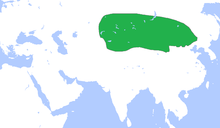
It has even been suggested that the Xiongnu themselves, who were mentioned in Han Dynasty records, wereProto-Turkicspeakers.[151][152][153][154]The Turks may ultimately have been of Xiongnu descent.[155]Although little is known for certain about the Xiongnu language(s), it seems likely that at least a considerable part of Xiongnu tribes spoke a Turkic language.[156]Some scholars believe they were probably a confederation of various ethnic and linguistic groups.[157][158]According to a study by Alexander Savelyev and Choongwon Jeong, published in 2020 in the journal Evolutionary Human Sciences by Cambridge University Press, "the predominant part of the Xiongnu population is likely to have spoken Turkic". However, genetic studies found a mixture of western and eastern Eurasian ancestries, suggesting a large genetic diversity within the Xiongnu. The Turkic-related component may be brought by eastern Eurasian genetic substratum.[159]
Using the only extant possibly Xiongnu writings, the rock art of theYinshanandHelan Mountains,[160]some scholars argue that the older Xiongnu writings are precursors to the earliest knownTurkicAlpha bet, theOrkhon script.Petroglyphs of this region dates from the9th millennium BCEto the 19th century, and consists mainly of engraved signs (petroglyphs) and few painted images.[161]Excavations done during 1924–1925 inNoin-Ulakurgans located in theSelengaRiver in the northernMongolianhills north ofUlaanbaatarproduced objects with over 20 carved characters, which were either identical or very similar to therunicletters of the Turkic Orkhon script discovered in theOrkhon Valley.[162]
Huns (4th–6th c. CE)

In the 18th century, the French scholarJoseph de Guignesbecame the first to propose a link between the Huns and theXiongnupeople, who were northern neighbours ofChinain the 3rd century BC.[163]TheHunhordes ruled byAttila,who invaded and conquered much of Europe in the 5th century, might have been, at least partially, Turkic and descendants of the Xiongnu.[134][164][165]Since Guignes' time, considerable scholarly effort has been devoted to investigating such a connection. The issue remains controversial. Their relationship to other peoples known collectively as theIranian Hunsis generally accepted, but whether these groups are all inter-related remains controversial.[166]
Some scholars claimed Huns asProto-MongolianorYeniseianin origin.[167][168]Linguisticstudies byOtto Maenchen-Helfenand others have suggested that thelanguage used by the Huns in Europewas too little documented to be classified. Nevertheless, the majority of the proper names used by Huns appear to be Turkic in origin,[169][170]though they are "far from unambiguous, so no firm conclusion can be drawn from this type of data".[171]
Steppe expansions
Göktürks – Turkic Khaganate (5th–8th c.)
The earliest certain mentioning of the politonym "Turk" was in the ChineseBook of Zhou.In the 540s AD, this text mentions that the Turks came to China's border seeking silk goods and a trade relationship. A Sogdian diplomat represented China in a series of embassies between theWestern Weidynasty and the Turks in the years 545 and 546.[173]
According to theBook of Suiand theTongdian,they were "mixed barbarians" (Tạp hồ;záhú) who migrated fromPingliang(now in modernGansu province,China) to theRouransseeking inclusion in their confederacy and protection from the prevailing dynasty.[174][175]Alternatively, according to theBook of Zhou,History of the Northern Dynasties,andNew Book of Tang,the Ashina clan was a component of theXiongnuconfederation.[176][177][178][179]Göktürks were also posited as having originated from an obscure Suo state ( tác quốc ), north of the Xiongnu.[180][181]The Ashina tribe were famedmetalsmithsand were granted land south of theAltai Mountains( kim sơnJinshan), which looked like ahelmet,from which they were said to have gotten their name Đột Quyết (Tūjué),[182][174]the first recorded use of "Turk" as a political name. In the 6th-century, Ashina's power had increased such that they conquered the Tiele on their Rouran overlords' behalf and even overthrew Rourans and established the First Turkic Khaganate.[183]
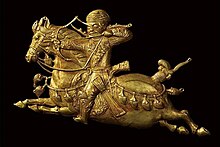
The originalOld TurkicnameKök Türkderives fromkök~kö:k,"sky, sky-coloured, blue, blue-grey".[184]Unlike its Xiongnu predecessor, the Göktürk Khaganate had its temporaryKhagansfrom theAshinaclan, who weresubordinateto asovereignauthority controlled by a council of tribal chiefs. TheKhaganateretained elements of its originalanimistic-shamanisticreligion, that later evolved intoTengriism,although it received missionaries ofBuddhistmonks and practiced a syncretic religion. The Göktürks were the first Turkic people to writeOld Turkicin a runic script, theOrkhon script.The Khaganate was also the first state known as "Turk". It eventually collapsed due to a series of dynastic conflicts, but many states and peoples later used the name "Turk".[185][186]
The Göktürks (First Turkic Kaganate) quickly spread west to the Caspian Sea. Between 581 and 603 theWestern Turkic Khaganatein Kazakhstan separated from theEastern Turkic Khaganatein Mongolia andManchuriaduring a civil war. The Han-Chinese successfully overthrew the Eastern Turks in 630 and created a military Protectorate until 682. After that time theSecond Turkic Khaganateruled large parts of the former Göktürk area. After several wars between Turks, Chinese and Tibetans, the weakened Second Turkic Khaganate was replaced by theUyghur Khaganatein the year 744.[187]
Bulgars, Golden Horde and the Siberian Khanate

TheBulgarsestablished themselves in between the Caspian and Black Seas in the 5th and 6th centuries, followed by their conquerors, theKhazarswho converted to Judaism in the 8th or 9th century. After them came thePechenegswho created a large confederacy, which was subsequently taken over by theCumansand theKipchaks.One group of Bulgars settled in the Volga region and mixed with localVolga Finnsto become theVolga Bulgarsin what is todayTatarstan.These Bulgars were conquered by the Mongols following their westward sweep underOgedei Khanin the 13th century.[188]Other Bulgars settled in Southeastern Europe in the 7th and 8th centuries, and mixed with theSlavicpopulation, adopting what eventually became the SlavicBulgarian language.Everywhere, Turkic groups mixed with the local populations to varying degrees.[183]
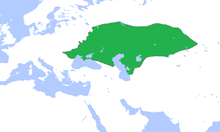
The Volga Bulgaria became an Islamic state in 922 and influenced the region as it controlled many trade routes. In the 13th century, Mongols invaded Europe and established theGolden Hordein Eastern Europe, western & northern Central Asia, and even western Siberia. TheCuman-Kipchak Confederationand IslamicVolga Bulgariawere absorbed by the Golden Horde in the 13th century; in the 14th century, Islam became the official religion underUzbeg Khanwhere the general population (Turks) as well as the aristocracy (Mongols) came to speak theKipchak languageand were collectively known as "Tatars"by Russians and Westerners. This country was also known as theKipchak Khanateand covered most of what is todayUkraine,as well as the entirety of modern-day southern and easternRussia(the European section). The Golden Horde disintegrated into several khanates and hordes in the 15th and 16th century including theCrimean Khanate,Khanate of Kazan,andKazakh Khanate(among others), which were one by one conquered and annexed by the Russian Empire in the 16th through 19th centuries.[189]
In Siberia, theSiberian Khanatewas established in the 1490s by fleeing Tatar aristocrats of the disintegratingGolden Hordewho established Islam as the official religion in western Siberia over the partly Islamized nativeSiberian Tatarsand indigenous Uralic peoples. It was the northernmost Islamic state in recorded history and it survived up until 1598 when it was conquered by Russia.[190]
Uyghur Khaganate (8th–9th c.)
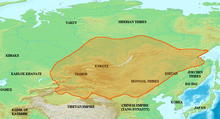


TheUyghur Khaganatehad established itself by the year 744 AD.[191]Through trade relations established with China, its capital city ofOrdu Baliqin central Mongolia'sOrkhon Valleybecame a wealthy center of commerce,[192]and a significant portion of the Uyghur population abandoned their nomadic lifestyle for asedentaryone. The Uyghur Khaganate produced extensive literature, and a relatively high number of its inhabitants were literate.[193]
The official state religion of the early Uyghur Khaganate wasManichaeism,which was introduced through the conversion ofBögü Qaghanby theSogdiansafter theAn Lushan rebellion.[194]The Uyghur Khaganate was tolerant of religious diversity and practiced variety of religions including Buddhism, Christianity, shamanism and Manichaeism.[195]
During the same time period, theShatuoTurks emerged as power factor in Northern and Central China and were recognized by the Tang Empire as allied power.
In 808, 30,000 Shatuo under Zhuye Jinzhong defected from the Tibetans to Tang China and the Tibetans punished them by killing Zhuye Jinzhong as they were chasing them.[196]The Uyghurs also fought against an alliance of Shatuo and Tibetans at Beshbalik.[197]
The Shatuo Turks under Zhuye Chixin (Li Guochang) served the Tang dynasty in fighting against their fellow Turkic people in theUyghur Khaganate.In 839, when the Uyghur khaganate (Huigu) general Jueluowu ( quật la chớ ) rose against the rule of then-reigningZhangxin Khan,he elicited the help from Zhuye Chixin by giving Zhuye 300 horses, and together, they defeated Zhangxin Khan, who then committed suicide, precipitating the subsequent collapse of the Uyghur Khaganate. In the next few years, when Uyghur Khaganate remnants tried to raid Tang borders, the Shatuo participated extensively in counterattacking the Uyghur Khaganate with other tribes loyal to Tang.[198]In 843, Zhuye Chixin, under the command of the Han Chinese officerShi Xiongwith Tuyuhun, Tangut and Han Chinese troops, participated in a raid against the Uyghur khaganate that led to the slaughter of Uyghur forces at Shahu mountain.[199][200][201]
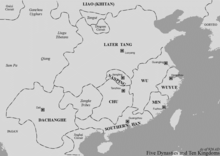
TheShatuoTurks had founded several short-livedsinicizeddynasties in northern China during theFive Dynasties and Ten Kingdoms periodstarting with Later Tang. The Shatuo chief Zhuye Chixin's family was adopted by the Tang dynasty and given the title prince of Jin and the Tang dynasty imperial surname of Li, which is why the Shatuo of Later Tang claimed to be restoring the Tang dynasty and not founding a new one. The official language of these dynasties was Chinese and they used Chinese titles and names. Some Shaotuo Turk emperors (of the Later Jin, Later Han and Northern Han) also claimed patrilineal Han Chinese ancestry.[202][203][204]
After the fall of the Tang-Dynasty in 907, the Shatuo Turks replaced them and created theLater TangDynasty in 923. The Shatuo Turks ruled over a large part of northern China, includingBeijing.They adopted Chinese names and united Turkic and Chinese traditions. Later Tang fell in 937 but the Shatuo rose to become a powerful faction of northern China. They created two other dynasties, including theLater JinandLater HanandNorthern Han(Later Han and Northern Han were ruled by the same family, with the latter being a rump state of the former). The Shatuo Liu Zhiyuan was a Buddhist and he worshipped theMengshan Giant Buddhain 945. The Shatuo dynasties were replaced by the Han ChineseSong dynasty.[205][206]The Shatuo became theOngudTurks living in Inner Mongolia after the Song dynasty conquered the last Shatuo dynasty of Northern Han.[207][208]The Ongud assimilated to the Mongols.[209][210][211][208]
The Yenisei Kyrgyz allied with China to destroy the Uyghur Khaganate in the year 840 AD.[187][205]From theYenisei River,the Kyrgyz pushed south and eastward in to Xin gian g and theOrkhon Valleyin central Mongolia, leaving much of the Uyghur civilization in ruins.[212]Much of the Uyghur population relocated to the southwest of Mongolia, establishing theGanzhou Uyghur Kingdomin Gansu where their descendants are the modern dayYugursandQocho Kingdomin Turpan, Xin gian g.[213]
Central Asia
Kangar union (659–750)

The Kangar Union (Qanghar Odaghu) was aTurkicstate in the former territory of the Western Turkic Khaganate (the entire present-day state ofKazakhstan,withoutZhetysu). The capital of the Kangar union was located in the Ulytau mountains. Among the Pechenegs, theKangar[note 1]formed the elite of the Pecheneg tribes. After being defeated by theKipchaks,Oghuz Turks,and theKhazars,they migrated west and defeatedMagyars,[214]and after forming an alliance with theBulgars,they defeated theByzantineArmy.[215]The Pecheneg state was established by the 11th century and at its peak carried a population of over 2.5 million, composed of many different ethnic groups.[216]
The elite of the Kangar tribes are believed to have had anIranianorigin,[217]and they likely spoke an Iranian language,[218]while most of the Pecheneg population spoke a Turkic language, with a significant percentage speakingHunno-Bulgardialects.
The Yatuks, a tribe within the Kangar state who could not accompany the Kangars as they migrated West, remained in the old lands, where they are known as theKanglypeople, who are now part of theUzbek,Kazakh,andKarakalpaktribes.[219]
Oghuz Yabgu State (766–1055)

The Oguz Yabgu State (Oguz il,meaning "Oguz Land", "Oguz Country" )(750–1055) was aTurkicstate, founded byOghuz Turksin 766, located geographically in an area between the coasts of theCaspianandAral Seas.Oguz tribes occupied a vast territory inKazakhstanalong theIrgiz,Yaik,Emba,andUilrivers, the Aral Sea area, theSyr Daryavalley, the foothills of theKaratau MountainsinTien-Shan,and theChui Rivervalley (see map). The Oguz political association developed in the 9th and 10th centuries in the Syr Darya basin.[220]
Salar Oghuz migration
TheSalarsare desended from Turkmen who migrated from Central Asia and settled in a Tibetan area of Qinghai under Ming Chinese rule. The Salar ethnicity formed and underwent ethnogenesis from a process of male Turkmen migrants from Central Asia marryingAmdoTibetanwomen during the early Ming dynasty.[221][222][223][224]
Iranian, Indian, Arabic, and Anatolian expansion
Turkic peoples and related groups migrated west from present-dayNortheastern China,Mongolia,Siberiaand theTurkestan-region towards theIranian plateau,South Asia, andAnatolia(modern Turkey) in many waves. The date of the initial expansion remains unknown.
Persia
Ghaznavid dynasty (977–1186)
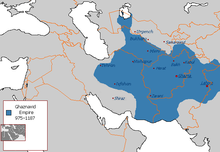
TheGhaznavid dynasty(Persian:غزنویانġaznaviyān) was aPersianate[225]Muslimdynasty of Turkicmamlukorigin,[226]at their greatest extent ruling large parts ofIran,Afghanistan,much ofTransoxianaand the northwestIndian subcontinent(part ofPakistan) from 977 to 1186.[227][228][229]The dynasty was founded bySabuktiginupon his succession to rule of the region ofGhaznaafter the death of his father-in-law,Alp Tigin,who was a breakaway ex-general of theSamanid EmpirefromBalkh,north of theHindu KushinGreater Khorasan.[230]
Although the dynasty was ofCentral AsianTurkic origin, it was thoroughlyPersianisedin terms of language, culture, literature and habits[231][232][233][234]and hence is regarded by some as a "Persian dynasty".[235]
Seljuk Empire (1037–1194)
This sectionneeds expansion.You can help byadding to it.(May 2019) |
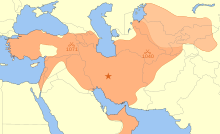
TheSeljuk Empire(Persian:آل سلجوق,romanized:Āl-e Saljuq,lit. 'House of Saljuq') or theGreat Seljuq Empire[236][237][238]was ahigh medievalTurko-Persian[239]Sunni Muslimempire,originating from theQiniqbranch ofOghuz Turks.[240]At its greatest extent, the Seljuk Empire controlled a vast area stretching from westernAnatoliaand theLevantto theHindu Kushin the east, and fromCentral Asiato thePersian Gulfin the south.
The Seljuk empire was founded byTughril Beg(1016–1063) and his brotherChaghri Beg(989–1060) in 1037. From their homelands near theAral Sea,the Seljuks advanced first intoKhorasanand then into mainlandPersia,before eventually conquering eastern Anatolia. Here the Seljuks won thebattle of Manzikertin 1071 and conquered most of Anatolia from theByzantine Empire,which became one of the reasons for thefirst crusade(1095–1099). From c. 1150–1250, the Seljuk empire declined, and was invaded by theMongolsaround 1260. The Mongols divided Anatolia intoemirates.Eventually one of these, theOttoman,would conquer the rest.[241]
Timurid Empire (1370–1507)
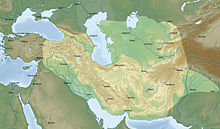
TheTimurid Empirewas a Turko-Mongol empire founded in the late 14th century through military conquests led byTimurlane.The establishment of a cosmopolitan empire was followed by theTimurid Renaissance,a period of local enrichment inmathematics,astronomy,architecture,as well as newfound economic growth.[242]The cultural progress of the Timurid period ended as soon as the empire collapsed in the early 16th century, leaving many intellecuals and artists to turn elsewhere in search of employment.[243]
Central Asian khanates (1501–1920)
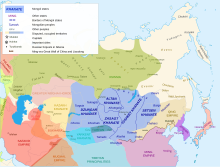
TheBukhara Khanatewas an Uzbek[244]state that existed from 1501 to 1785. The khanate was ruled by three dynasties of theShaybanids,Janids and the Uzbek dynasty of Mangits. In 1785,Shahmurad,formalized the family's dynastic rule (Manghitdynasty), and the khanate became theEmirate of Bukhara(1785–1920).[245]In 1710, the Kokand Khanate (1710–1876) separated from the Bukhara Khanate. In 1511–1920,Khwarazm(Khiva Khanate) was ruled by the Arabshahid dynasty and the Uzbek dynasty of Kungrats.[246]
Afsharid dynasty (1736–1796)
TheAfsharid dynastywas named after the Turkic Afshar tribe to which they belonged. The Afshars had migrated fromTurkestantoAzerbaijanin the 13th century. The dynasty was founded in 1736 by the military commanderNader Shahwho deposed the last member of theSafavid dynastyand proclaimed himself King ofIran.Nader belonged to the Qereqlu branch of the Afshars.[247]During Nader's reign, Iran reached its greatest extent since theSassanid Empire.
Qajar dynasty (1789–1925)
The Qajar dynasty was created by the TurkicQajar tribe,ruling over Iran from 1789 to 1925.[248][249]The Qajar family took full control of Iran in 1794, deposingLotf 'Ali Khan,the lastShahof theZand dynasty,and re-asserted Iranian sovereignty over large parts of theCaucasus.In 1796,Mohammad Khan QajarseizedMashhadwith ease,[250]putting an end to theAfsharid dynasty,and Mohammad Khan was formally crowned as Shah after hispunitive campaign against Iran's Georgian subjects.[251]In the Caucasus, the Qajar dynasty permanently lost many of Iran's integral areas[252]to theRussiansover the course of the 19th century, comprising modern-dayGeorgia,Dagestan,AzerbaijanandArmenia.[253]The dynasty was founded byAgha Mohammad Khan Qajarand continued untilAhmad Shah Qajar.
South Asia
TheDelhi Sultanateis a term used to cover five short-lived,Delhi-based kingdoms, two of which were of Turkic origins: theMamluk dynasty(1206–90) and theTughlaq dynasty(1320–1414).Southern Indiasaw rise of theQutb Shahi dynasty,one of theDeccan sultanates. TheMughal Empirewas a Turko-Mongol empire that, at its greatest territorial extent, ruled most of South Asia, includingAfghanistan,Pakistan, India,Bangladeshand parts ofUzbekistanfrom the early 16th to the early 18th centuries. The Mughal dynasty was founded by aTurko-Mongolprince namedBabur(reigned 1526–30), who was descended fromTimur(Tamerlane) on his father's side and from Chagatai, second son of theMongolrulerGenghis Khan,on his mother's side.[254][255]A further distinction was the attempt of the Mughals to integrate Hindus and Muslims into a united Indian state.[254][256][257][258]
Arab world
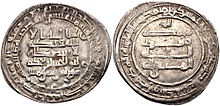
The Arab MuslimUmayyadsandAbbasidsfought against the pagan Turks in theTürgeshKhaganate in theMuslim conquest of Transoxiana.Turkic soldiers in the army of theAbbasidcaliphsemerged as the de facto rulers of most of the Muslim Middle East (apart fromSyriaandEgypt), particularly after the 10th century. Examples of regional de facto independent states include the short livedTulunidsandIkhshididsin Egypt. TheOghuzand other tribes captured and dominated various countries under the leadership of theSeljuk dynastyand eventually captured the territories of the Abbasid dynasty and theByzantine Empire.[183]
Anatolia – Ottomans
After many battles, the westernOghuz Turksestablished their own state and later constructed theOttoman Empire.The main migration of the Oghuz Turks occurred in medieval times, when they spread across most of Asia and into Europe and the Middle East.[183]They also took part in the military encounters of theCrusades.[259]In 1090–91, the Turkic Pechenegs reached the walls ofConstantinople,where EmperorAlexius Iwith the aid of the Kipchaks annihilated their army.[260]
As theSeljuk Empiredeclined following theMongol invasion,theOttoman Empireemerged as the new important Turkic state, that came to dominate not only the Middle East, but even southeastern Europe, parts of southwestern Russia, and northern Africa.[183]
Islamization
Turkic peoples like theKarluks(mainly 8th century),Uyghurs,Kyrgyz,Turkmens,andKipchakslater came into contact withMuslims,and most of them gradually adoptedIslam.Some groups of Turkic people practice other religions, including their original animistic-shamanistic religion,Christianity,Burkhanism,Judaism(Khazars,Krymchaks,Crimean Karaites),Buddhism,and a small number ofZoroastrians.
Modern history
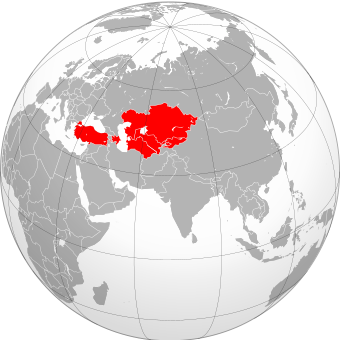
The Ottoman Empire gradually grew weaker in the face of poor administration, repeated wars withRussia,Austria and Hungary, and theemergence of nationalist movements in the Balkans,and it finally gave way after World War I to the present-dayRepublic of Turkey.[183] Ethnic nationalism also developed in Ottoman Empire during the 19th century, taking the form ofPan-TurkismorTuranism.
The Turkic peoples of Central Asia were not organized in nation-states during most of the 20th century, after the collapse of theRussian Empireliving either in the Soviet Union or (after a short-livedFirst East Turkestan Republic) in theChinese Republic.For much of the 20th century, Turkey was the only independent Turkic country.[261]
In 1991, after the disintegration of theSoviet Union,five Turkic states gained their independence. These wereAzerbaijan,Kazakhstan,Kyrgyzstan,Turkmenistan,andUzbekistan.Other Turkic regions such asTatarstan,Tuva,andYakutiaremained in theRussian Federation.Chinese Turkestanremained part of thePeople's Republic of China.Immediately after the independence of the Turkic states, Turkey began seeking diplomatic relations with them. Over time political meetings between the Turkic countries increased and led to the establishment ofTÜRKSOYin 1993 and theTurkic Councilin 2009, which later was renamedOrganization of Turkic Statesin 2021.[262]
Physiognomy
According to historians Joo-Yup Lee and Shuntu Kuang, Chinese official histories do not depict Turkic peoples as belonging to a single uniform entity called "Turks".[263]However "Chinese histories also depict the Turkic-speaking peoples as typically possessing East/Inner Asianphysiognomy,as well as occasionally having West Eurasian physiognomy. "[263]According to "fragmentary information on the Xiongnu language that can be found in the Chinese histories, the Xiongnu were Turkic",[264]however historians have been unable to confirm whether or not they were Turkic.Sima Qian's description of their legendary origins suggest their physiognomy was "not too different from that of... Han ( hán ) Chinese population",[264]but a subset of Xiongnu known as theJie peoplewere described having "deep-set eyes", "high nose bridges" and "heavy facial hair".[264]The Jie may have beenYeniseian,although others maintaining anIranianaffiliation, and regardless of whether or not the Xiongnu were Turkic, they were a hybrid people.[265]According to theOld Book of Tang,Ashina Simo"was not given a high military post by the Ashina rulers because of his Sogdian (hurenNgười Hồ ) physiognomy. "[266]TheTanghistorianYan Shigudescribed the Hu people of his day as "blue-eyed and red bearded"[267]descendants of theWusun,whereas "no comparable depiction of the Kök Türks or Tiele is found in the official Chinese histories."[267]

HistorianPeter Goldenhas reported that genetic testing of the proposed descendants of the Ashina tribe does seem to confirm a link to theIndo-Iranians,emphasizing that "the Turks as a whole 'were made up of heterogeneous and somatically dissimilar populations'".[271]HistorianEmel Esinand ProfessorXue Zongzhenghave argued that West Eurasian features were typical of the royalAshina clanof the Eastern Turkic Khaganate and that their appearance shifted to an East Asian one due to intermarriage with foreign nobility. As a result, by the time ofKul Tigin(684 AD), members of the Ashina dynasty had East Asian features.[272][273]A 2023 genetic study found thatEmpress Ashina(568–578 AD), a Royal Göktürk, had nearly entirelyAncient Northeast Asianorigin, weakening the "western Eurasian origin and multiple origin hypotheses".[127]Lee and Kuang believe it is likely "early and medieval Turkic peoples themselves did not form a homogeneous entity and that some of them, non-Turkic by origin, had become Turkicised at some point in history."[274]They also suggest that many modern Turkic-speaking populations are not directly descended from early Turkic peoples.[274]Lee and Kuang concluded that "both medieval Chinese histories and modern DNA studies point to the fact that the early and medieval Turkic peoples were made up of heterogeneous and somatically dissimilar populations."[275]
Like Chinese historians, Medieval Muslim writers generally depicted the Turks as having an East Asian appearance.[276]Unlike Chinese historians, Medieval Muslim writers used the term "Turk" broadly to refer to not only Turkic-speaking peoples but also various non-Turkic speaking peoples,[276]such as theHephthalites,Rus,Magyars,andTibetans.In the 13th century,Juzjanireferred to the people of Tibet and the mountains between Tibet and Bengal as "Turks" and "people with Turkish features."[277]Medieval Arab and Persian descriptions of Turks state that they looked strange from their perspective and were extremely physically different from Arabs. Turks were described as "broad faced people with small eyes", having light-colored, often reddish hair, and with pink skin,[278]as being "short, with small eyes, nostrils, and mouths" (Sharaf al-Zaman al-Marwazi), as being "full-faced with small eyes" (Al-Tabari), as possessing "a large head (sar-i buzurg), a broad face (rūy-i pahn), narrow eyes (chashmhā-i tang), and a flat nose (bīnī-i pakhch), and unpleasing lips and teeth (lab va dandān na nīkū) "(Keikavus).[279]OnWestern Turkiccoins "the faces of the governor and governess are clearly Mongoloid (a roundish face, narrow eyes), and the portrait have definite old Türk features (long hair, absence of headdress of the governor, a tricorn headdress of the governess)".[280]

In theGhaznavids' residential palace ofLashkari Bazar,there survives a partially conserved portrait depicting a turbaned and haloed adolescent figure with full cheeks, slanted eyes, and a small, sinuous mouth.[281]The Armenian historianMovses Kaghankatvatsidescribes the Turks of theWestern Turkic Khaganateas "broad-faced, without eyelashes, and with long flowing hair like women".[282]
Al-Masudiwrites that theOghuz Turksin Yengi-kent near the mouth of theSyr Darya"are distinguished from other Turks by their valour, their slanted eyes, and the smallness of their stature."[276]Later Muslim writers noted a change in the physiognomy of Oghuz Turks. According toRashid al-Din Hamadani,"because of the climate their features gradually changed into those of Tajiks. Since they were not Tajiks, the Tajik peoples called themturkmān,i.e. Turk-like (Turk-mānand). "Ḥāfiẓ Tanīsh Mīr Muḥammad Bukhārī also related that the Oghuz' 'Turkic face did not remain as it was' after their migration intoTransoxianaandIran.KhivakhanAbu al-Ghazi Bahadurwrote in hisChagatai languagetreatiseShajara-i Tarākima(Genealogy of the Turkmens) that "their chin started to become narrow, their eyes started to become large, their faces started to become small, and their noses started to become big' after five or six generations". Ottoman historianMustafa Âlîcommented inKünhüʾl-aḫbārthat Anatolian Turks and Ottoman elites are ethnically mixed: "Most of the inhabitants ofRûmare of confused ethnic origin. Among its notables there are few whose lineage does not go back to a convert to Islam. "[283]
Kevin Alan Brook states that like "most nomadic Turks, the Western TurkicKhazarswere racially and ethnically mixed. "[284]Istakhridescribed Khazars as having black hair whileIbn Sa'id al-Maghribidescribed them as having blue eyes, light skin, and reddish hair. Istakhri mentions that there were "Black Khazars" and "White Khazars." Most scholars believe these were political designations: black being lower class while white being higher class. Constantin Zuckerman argues that these "had physical and racial differences and explained that they stemmed from the merger of the Khazars with the Barsils."[285]Old East Slavicsources called the Khazars the "White Ugry" and the Magyars the "Black Ugry."[286]Soviet excavated Khazar remains show Slavic-type, European-type, and a minority Mongoloid-type skulls.[285]
TheYenisei Kyrgyzare mentioned in theNew Book of Tangas having the same script and language as theUyghursbut "The people are all tall and big and have red hair, white faces, and green eyes."[287][note 2]TheNew Book of Tangalso states that the neighboring Boma tribe resembled the Kyrgyz but their language was different, which may imply the Kyrgyz were originally a non-Turkic people, who were later Turkicized through inter-tribal marriages.[287]According toGardizi,the Kyrgyz were mixed with "Saqlabs" (Slavs), which explains the red hair and white skin among the Kyrgyz, while theNew Bookstates that the Kyrgyz "intermixed with the Dingling."[292][293]The Kyrgyz "regarded those with black eyes as descending from [Li] Ling," aHan dynastygeneral who defected to the Xiongnu.[294]
In a Chinese legal statute from the early period of theMing dynasty,theKipchaksare described as having blond hair andblueeyes. It also states that they had a "vile" and "peculiar" appearance, and that some Chinese people would not want to marry them.[295][296]Russian anthropologist Oshanin (1964: 24, 32) notes that "the 'Mongoloid' phenotype, characteristic of modern Kazakhs and Qirghiz, prevails among the skulls of the Qipchaq and Pecheneg nomads found in the kurgans in eastern Ukraine"; Lee & Kuang (2017) propose that Oshanin's discovery is explainable by assuming that the historical Kipchaks' modern descendants areKazakhsof theLesser Horde,whose men possess a high frequency of haplogroup C2's subclade C2b1b1 (59.7 to 78%). Lee and Kuang also suggest that the high frequency (63.9%) of the Y-DNA haplogroup R-M73 among Karakypshaks (a tribe within the Kipchaks) allows inference about the genetics of Karakypshaks' medieval ancestors, thus explaining why some medieval Kipchaks were described as possessing "blue [or green] eyes and red hair.[297]
Byzantine historians of the 11th-12th centuries provided description of Turkmens as very different from the Greeks.Bertrandon de la Broquière,a French traveller to theOttoman Empire,met with sultanMurad IIinAdrianople,and described him in the following terms: "In the first place, as I have seen him frequently, I shall say that he is a little, short, thick man, with the physiognomy of aTartar.He has a broad and brown face, high cheek bones, a round beard, a great and crooked nose, with little eyes ".[298]
Remarks
- ^For its etymology seeKangar union#Etymology
- ^9th-century authorDuan Chengshidescribed the Kyrgyz tribe (Jiankun buluoKiên côn bộ lạc ) as "yellow-haired, green-eyed, red-mustached [and red-]bearded".[288]New Book of Tang(finished in 1060) describesAlats,a medieval Turkic people, as resembling Kyrgyzes[289]who were "all tall, red-haired, pale-faced, green-irised";[290]New Book of Tang also states that Kyrgyzes regarded black hair as "infelicitous" and insisted that black-eyed individuals were descendants ofHangeneralLi Ling.[291]
Archaeology
- Xinglongwa culture
- Hongshan culture
- Čaatas culture
- Askiz culture
- Kurumchi culture
- Saltovo-Mayaki
- Saymaluu-Tash
- Bilär
- Por-Bazhyn
- Ordu-Baliq
- Jankent
International organizations

There are several international organizations created with the purpose of furthering cooperation between countries with Turkic-speaking populations, such as theJoint Administration of Turkic Arts and Culture(TÜRKSOY) and the Parliamentary Assembly of Turkic-speaking Countries (TÜRKPA) and theTurkic Council.

TheTAKM– Organization of the Eurasian Law Enforcement Agencies with Military Status, was established on 25 January 2013. It is anintergovernmentalmilitarylaw enforcement(gendarmerie) organization of currently three Turkic countries (Azerbaijan,KyrgyzstanandTurkey) andKazakhstanas observer.
TÜRKSOY
Türksoy carries out activities to strengthen cultural ties between Turkic peoples. One of the main goals to transmit their common cultural heritage to future generations and promote it around the world.[299]
Every year, one city in the Turkic world is selected as the "Cultural Capital of the Turkic World". Within the framework of events to celebrate the Cultural Capital of the Turkic World, numerous cultural events are held, gathering artists, scholars and intellectuals, giving them the opportunity to exchange their experiences, as well as promoting the city in question internationally.[300]
Organization of Turkic States
TheOrganization of Turkic States,founded on 3 November 2009, by theNakhchivan Agreementconfederation,Kazakhstan,KyrgyzstanandTurkey,aims to integrate these organizations into a tighter geopolitical framework.
The member countries areAzerbaijan,Kazakhstan,Kyrgyzstan,TurkeyandUzbekistan.[301]The idea of setting up this cooperative council was first put forward by Kazakh PresidentNursultan Nazarbayevback in 2006.Hungaryhas announced to be interested in joining the Organization of Turkic States. Since August 2018, Hungary has official observer status in the Organization of Turkic States.[302]Turkmenistanalso joined as an observer state to the organization at 8th summit.[303]Turkish Republic of Northern Cypruswas admitted to the organization as observer member at the2022 Samarkand Summit.[304][305]
Demographics

The distribution of people of Turkic cultural background ranges fromSiberia,across Central Asia, to Southern Europe. As of 2011[update]the largest groups of Turkic people live throughout Central Asia—Kazakhstan,Kyrgyzstan,Turkmenistan,Uzbekistan,andAzerbaijan,in addition toTurkeyandIran.Additionally, Turkic people are found withinCrimea,Altishahrregion of westernChina,northernIraq,Israel,Russia,Afghanistan,Cyprus,and theBalkans:Moldova,Bulgaria,Romania,Greeceand formerYugoslavia.
A small number of Turkic people also live inVilnius,the capital ofLithuania.Small numbers inhabit easternPolandand the south-eastern part ofFinland.[306]There are also considerable populations of Turkic people (originating mostly fromTurkey) inGermany,United States,andAustralia,largely because of migrations during the 20th century.
Sometimes ethnographers group Turkic people into six branches: theOghuz Turks,Kipchak,Karluk,Siberian,Chuvash,andSakha/Yakutbranches. The Oghuz have been termed Western Turks, while the remaining five, in such a classificatory scheme, are called Eastern Turks.[citation needed]
The genetic distances between the different populations of Uzbeks scattered across Uzbekistan is no greater than the distance between many of them and the Karakalpaks. This suggests that Karakalpaks and Uzbeks have very similar origins. The Karakalpaks have a somewhat greater bias towards the eastern markers than the Uzbeks.[307]
Historical population:
| Year | Population |
|---|---|
| 1 AD | 2–2.5 million? |
| 2013 | 150–200 million |
The following incomplete list of Turkic people shows the respective groups' core areas of settlement and their estimated sizes (in millions):
| People | Primary homeland | Population | Modern language | Predominant religion and sect |
|---|---|---|---|---|
| Turkish people | Turkey | 70 M | Turkish | Sunni Islam |
| Azerbaijanis | Iranian Azerbaijan,Republic of Azerbaijan | 30–35 M | Azerbaijani | Shia Islam (65%), Sunni Islam (35%)[308][309](Hanafi). |
| Uzbeks | Uzbekistan | 28.3 M | Uzbek | Sunni Islam |
| Kazakhs | Kazakhstan | 13.8 M | Kazakh | Sunni Islam |
| Uyghurs | Altishahr(China) | 9 M | Uyghur | Sunni Islam |
| Turkmens | Turkmenistan | 8 M | Turkmen | Sunni Islam |
| Tatars | Tatarstan(Russia) | 7 M | Tatar | Sunni Islam |
| Kyrgyzs | Kyrgyzstan | 4.5 M | Kyrgyz | Sunni Islam |
| Bashkirs | Bashkortostan(Russia) | 2 M | Bashkir | Sunni Islam |
| Crimean Tatars | Crimea(Russia/Ukraine) | 0.5 to 2 M | Crimean Tatar | Sunni Islam |
| Chuvashes | Chuvashia(Russia) | 1.7 M | Chuvash | Orthodox Christianity |
| Qashqai | Southern Iran(Iran) | 0.9 M | Qashqai | Shia Islam |
| Karakalpaks | Karakalpakstan(Uzbekistan) | 0.6 M | Karakalpak | Sunni Islam |
| Yakuts | Yakutia(Russia) | 0.5 M | Sakha | Orthodox Christianity and Turkic Paganism |
| Kumyks | Dagestan(Russia) | 0.4 M | Kumyk | Sunni Islam |
| KarachaysandBalkars | Karachay-CherkessiaandKabardino-Balkaria(Russia) | 0.4 M | Karachay-Balkar | Sunni Islam |
| Tuvans | Tuva(Russia) | 0.3 M | Tuvan | Tibetan Buddhism |
| Gagauzs | Gagauzia(Moldova) | 0.2 M | Gagauz | Orthodox Christianity |
| Turkic KaraitesandKrymchaks | Ukraine | 0.004 M | KaraimandKrymchak | Judaism |
Cuisine
Markets in the steppe region had a limited range of foodstuffs available—mostlygrains,dried fruits,spices,andtea.Turks mostly herdedsheep,goatsandhorses.Dairy was a staple of the nomadic diet and there are many Turkic words for various dairy products such assüt(milk),yagh(butter),ayran,qaymaq(similar toclotted cream),qi̅mi̅z(fermented mare's milk) andqurut(dried yoghurt). During the Middle AgesKazakh,KyrgyzandTatars,who were historically part of the Turkic nomadic group known as theGolden Horde,continued to develop new variations of dairy products.[310]
Nomadic Turks cooked their meals in aqazan,a pot similar to acauldron;a wooden rack called aqasqancan be used to prepare certain steamed foods, like the traditional meat dumplings calledmanti.They also used asaj,a griddle that was traditionally placed on stones over a fire, andshish.In later times, the Persiantavawas borrowed from the Persians for frying, but traditionally nomadic Turks did most of their cooking using the qazan, saj and shish. Meals were served in a bowl, called achanaq,and eaten with a knife (bïchaq) and spoon (qashi̅q). Both bowl and spoon were historically made from wood. Other traditional utensils used in food preparation included a thin rolling pin calledoqlaghu,acolandercalledsüzgu̅çh,and a grinding stone calledtāgirmān.[310]
Medieval grain dishes included preparations of whole grains, soups, porridges, breads and pastries. Fried or toasted whole grains were calledqawïrmach,whileköchäwas crushed grain that was cooked with dairy products.Salmawere broadnoodlesthat could be served with boiled or roasted meat; cut noodles were calledtutmajin the Middle Ages and are calledkesmetoday.[310]
There are many types of bread doughs in Turkic cuisine.Yupqais the thinnest type of dough,bawi̅rsaqis a type of fried bread dough, andchälpäkis a deep fried flat bread.Qatlamais a fried bread that may be sprinkled with dried fruit or meat, rolled, and sliced likepinwheel sandwiches.Toqachandchöräkare varieties of bread, andböräkis a type of filled piepastry.[310]
Herd animals were usually slaughtered during the winter months and various types of sausages were prepared to preserve the meats, including a type of sausage calledsujuk.Though prohibited byIslamic dietary restrictions,historically Turkic nomads also had a variety ofblood sausage.One type of sausage, calledqazi̅,was made from horsemeat and another variety was filled with a mixture of ground meat,offaland rice. Chopped meat was calledqïymaand spit-roasted meat wassöklünch—from the rootsök-meaning "to tear off", the latter dish is known askebabin modern times.Qawirmais a typical fried meat dish, andkullamais a soup of noodles and lamb.[310]
Religion
Early Turkic mythology and Tengrism


EarlyTurkic mythologywas dominated byShamanism,AnimismandTengrism.The Turkic animistic traditions were mostly focused onancestor worship,polytheistic-animismandshamanism.Later this animistic tradition would form the more organized Tengrism.[citation needed]The chief deity wasTengri,asky god,worshipped by the upper classes of early Turkic society untilManichaeismwas introduced as the official religion of theUyghur Empirein 763.
Thewolfsymbolizes honour and is also considered the mother of most Turkic peoples.Ashinais the wolf mother ofTumen Il-Qağan,the first Khan of theGöktürks.Thehorseandpredatory birds,such as theeagleorfalcon,are also main figures of Turkic mythology.[citation needed]
Religious conversions
Buddhism
Buddhismplayed an important role in the history of Turkic peoples, with the first Turkic state adopting and supporting the spread of Buddhism being the Turkic Shahis and the Göktürks. The Göktürks syncretized Buddhism with their traditional religionTengrismand also incorporated elements of the Iranian traditional religions, such asZoroastrianism.Buddhism had its height among theUyghursin theXin gian gregion.[311]Buddhism had also considerable impact and influence onto various other historical Turkic groups. In pre-Islamic times, Buddhism andTengrismcoexisted, with several Buddhist temples, monasteries, figures and steles, with images of Buddhist characters and sceneries, were constructed by various Turkic tribes. ThroughoutKazakhstan,there exist various historical Buddhist sites, including an underground Buddhist cave monastery. After theArab conquest of Central Asia,and the spread of Islam among locals, Buddhism (and Tengrism) started to lose ground, however a certain influence of the Buddhist teachings remained during the next centuries.[312]
Tengri Bögü Khan initially made the now extinctManichaeismthe state religion of theUyghur Khaganatein 763 and it was also popular among theKarluks.It was gradually replaced by theMahayana Buddhism.[citation needed]It existed in the Buddhist UyghurGaochangup to the 12th century.[313]
Tibetan Buddhism,orVajrayanawas the main religion after Manichaeism.[314]They worshippedTäŋri Täŋrisi Burxan,[315]Quanšï Im Pusar[316]andMaitri Burxan.[317]TurkicMuslim conquest in the Indian subcontinentand westXin gian gattributed with a rapid and almost total disappearance of it and other religions in North India and Central Asia. TheSari Uygurs"Yellow Yughurs" of Western China, as well as theTuvansof Russia are the only remainingBuddhistTurkic peoples.[318]
Islam

Most Turkic people today areSunniMuslims,although a significant number in Turkey areAlevis.Alevi Turks, who were once primarily dwelling in eastern Anatolia, are today concentrated in major urban centers in western Turkey with the increased urbanism. Turkic Sunni Muslims generally follow theHanafirite. Azeris are traditionally Shiite Muslims. Religious observance is less strict in the Republic of Azerbaijan compared to Iranian Azerbaijan.

Islam first made contact with the Turkic peoples in 642, when Muslim armies crossed theAmu Daryaafter toppling theSassanid Empirethe year before. Some of the earliest rulers to convert to Islam were the Turkic princes of the city-states in the region ofSogdiana.Mass conversions did not take place until theBattle of Talasin 751, in which Turkic tribes sided with the Arabs against Chinese forces, which marked a significant milestone in the history of Islam in the region. From then onwards much of the Turkic heartland became Muslim.[319]In the 19th century, Turkic Muslim progressives in the Russian Empire spearheaded a reformist movement calledJadidism,calling for a return to basic Islamic beliefs while simultaneously accepting modernist trends.
Christianity

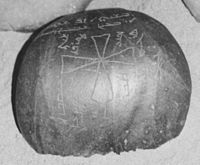
The major Christian-Turkic peoples are theChuvashofChuvashiaand theGagauz(Gökoğuz) ofMoldova,the vast majority ofChuvashand theGagauzareEastern Orthodox Christians.[320][321][322]The traditional religion of theChuvashof Russia, while containing many ancient Turkic concepts, also shares some elements withZoroastrianism,KhazarJudaism, and Islam. The Chuvash converted toEastern Orthodox Christianityfor the most part in the second half of the 19th century.[321]As a result, festivals and rites were made to coincide with Orthodox feasts, and Christian rites replaced their traditional counterparts. A minority of the Chuvash still profess their traditional faith.[323]Between the 9th and 14th centuries,Church of the Eastwas popular among Turks such as theNaimans.[324]It even revived in Gaochang and expanded inXin gian gin theYuan dynastyperiod.[325][326][327]It disappeared after its collapse.[328][329]
Kryashensare a sub-group of theVolga Tatars,and the vast majority areOrthodox Christians.[330]Nağaybäkare an indigenous Turkic people in Russia, most Nağaybäk are Christian and were largely converted during the 18th century.[331]ManyVolga TatarswereChristianizedbyIvan the Terribleduring the 16th century, and continued to Christianized under subsequent Russian rulers and Orthodox clergy up to the mid-eighteenth century.[332]
Animism
Today there are several groups that support a revival of the ancient traditions. Especially after the collapse of theSoviet Union,many inCentral Asiaconverted or openly practice animistic and shamanistic rituals. It is estimated that about 60% ofKyrgyz peoplepractice a form of animistic rituals. InKazakhstanthere are about 54,000 followers of the ancient traditions.[333][334]
Muslim Turks and non-Muslim Turks
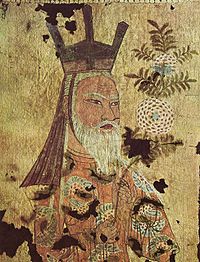
The Uyghur Turks, who once belonged to a variety of religions, were gradually Islamized during a period spanning the 10th and 13th centuries. Some scholars have linked the phenomenon of recently Islamized Uyghur soldiers recruited by theMongol Empireto the slow conversion of Uyghur populations to Islam.[335][336]
The non-Muslim Turks' worship ofTengriand other gods was mocked and insulted by the Muslim TurkMahmud al-Kashgari,who wrote a verse referring to them –The Infidels – May God destroy them![337][338]
The Basmil, Yabāḳu and Uyghur states were among the Turkic peoples who fought against the Kara-Khanids spread of Islam. The Islamic Kara-Khanids were made out ofTukhsi,Yaghma, Çiğil and Karluk.[339]
Kashgari claimed that the Prophet assisted in a miraculous event where 700,000 Yabāqu infidels were defeated by 40,000 Muslims led by Arslān Tegīn claiming that fires shot sparks from gates located on a green mountain towards the Yabāqu.[340]The Yabaqu were a Turkic people.[341]
Mahmud al-Kashgariinsulted the Uyghur Buddhists as "Uighur dogs" and called them "Tats", which referred to the "Uighur infidels" according to the Tuxsi and Taghma, while other Turks called Persians "tat".[342][343]While Kashgari displayed a different attitude towards the Turks diviners beliefs and "national customs", he expressed towards Buddhism a hatred in his Diwan where he wrote the verse cycle on the war against Uighur Buddhists. Buddhist origin words like toyin (a cleric or priest) and Burxān or Furxan (meaning Buddha, acquiring the generic meaning of "idol" in the Turkic language of Kashgari) had negative connotations to Muslim Turks.[344][338]
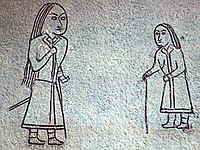

Old sports
Tepuk
Mahmud al-Kashgariin hisDīwān Lughāt al-Turk,described a game called "tepuk" among Turks in Central Asia. In the game, people try to attack each other's castle by kicking a ball made of sheep leather.[345](see also:Cuju)
Kyz kuu
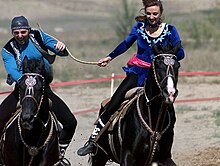
Kyz kuu(chase the girl) has been played by Turkic people at festivals since time immemorial.[346]
Jereed
Horses have been essential and even sacred animals for Turks living as nomadic tribes in the Central Asian steppes. Turks were born, grew up, lived, fought and died on horseback.Jereedbecame the most important sporting and ceremonial game of Turkish people.[347]
Kokpar
Thekokparbegan with the nomadic Turkic peoples who have come from farther north and east spreading westward from China and Mongolia between the 10th and 15th centuries.[348]
Jigit
"jigit"is used in the Caucasus and Central Asia to describe a skillful and brave equestrian, or a brave person in general.[349]
Gallery
Battle, hunting and blacksmithing scenes in Turkic rock art of the early Middle Ages in Altai
-
Turk vassal blacksmiths under Mongolian rule
-
Turkic hunting scene, Gokturk period Altai
-
Battle scene of a Turkic horseman with typical long hair (Gokturk period, Altai)
Bezeklik caves and Mogao grottoes
Images of Buddhist and ManicheanOld Uyghursfrom theBezeklik cavesandMogao grottoes.
-
Old Uyghur king from Turfan, from the murals at the Dunhuang Mogao Caves.
-
Old Uyghur prince from the Bezeklik murals.
-
Old Uyghur woman from the Bezeklik murals.
-
Old Uyghur Princess.
-
Old Uyghur Princesses from the Bezeklik murals.
-
Old Uyghur Princes from the Bezeklik murals.
-
Old Uyghur Prince from the Bezeklik murals.
-
Old Uyghur noble from the Bezeklik murals.
-
Old UyghurManichaeanElect depicted on a temple banner fromQocho.
-
Old Uyghur donor from the Bezeklik murals.
-
Old Uyghur Manichaean Electae from Qocho.
-
Old Uyghur Manichaean clergymen from Qocho.
-
Manicheans from Qocho
Medieval times
Modern times
-
Azerbaijanigirls in traditional dress.
-
Bashkirboys in national dress.
-
AChuvashgirl in traditional dress.
-
Khakas peoplewith traditional instruments.
-
Nogaiman in national costume.
-
Turkish girls in their traditional clothes,Dursunbey,Balikesir Province.
-
Turkmengirl in national dress.
-
Kazakhman in traditional clothing.
-
Uzbekwith traditional cuisine.
-
Kyrgyztraditional eagle hunter.
-
Tuvantraditional shaman.
See also
References
- ^abcYunusbayev et al. 2015.
- ^Garibova, Jala (2011),"A Pan-Turkic Dream: Language Unification of Turks",in Fishman, Joshua; Garcia, Ofelia (eds.),Handbook of Language and Ethnic Identity: The Success-Failure Continuum in Language and Ethnic Identity Efforts,Oxford University Press,p. 268,ISBN978-0-19-983799-1,
Approximately 200 million people,... speak nearly 40 Turkic languages and dialects. Turkey is the largest Turkic state, with about 60 million ethnic Turks living in its territories.
- ^Hobbs, Joseph J. (2017),Fundamentals of World Regional Geography,Cengage,p. 223,ISBN978-1-305-85495-6,
The greatest are the 65 million Turks of Turkey, who speak Turkish, a Turkic language...
- ^"Uzbekistan".Statistics Committee of the Republic of Uzbekistan.19 August 2021.Retrieved13 February2022."Population: 34,600,000 (January 2021 est.)" "Ethnic groups: Uzbek 84.6%, Russian 2.1%, Tajik 4.9%, Kazakh 2.4%, Karakalpak 2.2%, other 4.1% (2021 est.)" Assuming Uzbek, Kazakh and Karakalpak are included as Turks, 84.6% + 2.4% + 2.2% = 89.2%. 89.2% of 34.6m = 31.9m
- ^"Azerbaijani (people)".Encyclopædia Britannica.Retrieved24 January2012.(15 million)
- ^Egbert Jahn,(2009).Nationalism in Late and Post-Communist Europe,p. 293 (20 mil)
- ^Library of Congress – Federal Research Division – Country Profile: Iran, May 2008, page 5[1]
- ^"Kazakhstan".The World Factbook.Retrieved21 December2014."Population: 17,948,816 (July 2014 est.)" "Ethnic groups: Kazakh (Qazaq) 63.1%, Russian 23.7%, Uzbek 2.9%, Ukrainian 2.1%, Uighur 1.4%, Tatar 1.3%, German 1.1%, other 4.4% (2009 est.)" Assuming Kazakh, Uzbek, Uighur and Tatar are included as Turks, 63.1% + 2.9% + 1.4% + 1.3% = 68.7%. 68.7% of 17.9m = 12.3m
- ^"China".The World Factbook.Retrieved13 May2014.
- ^"Azerbaijan".The World Factbook.Retrieved30 July2016."Population: 9,780,780 (July 2015 est.)"
- ^"Census 2021: 84.6% of population define themselves as Bulgarians, 8.4% Turks, 4.4% Roma".24 November 2022.
- ^"Afghanistan".The World Factbook.Retrieved13 May2014.
- ^"Uzbeks and Turkmens – Minorities and indigenous peoples in Afghanistan".World Directory of Minorities and Indigenous Peoples. 19 June 2015.
- ^Turner, B. (7 February 2017).The Statesman's Yearbook 2007: The Politics, Cultures and Economies of the World.Springer. p. 1238.ISBN978-0-230-27135-7.
- ^Leitner, Gerhard; Hashim, Azirah; Wolf, Hans-Georg (11 January 2016).Communicating with Asia: The Future of English as a Global Language.Cambridge University Press. p. 241.ISBN978-1-107-06261-0.
- ^Dresser, Norine (7 January 2011).Multicultural Manners: Essential Rules of Etiquette for the 21st Century.Wiley. p. 270.ISBN978-1-118-04028-7.
- ^"Unpublished Census Provides Rare and Unvarnished Look at Turkmenistan".Jamestown.
- ^"First (actual) demographic data for Turkmenistan released".asianews.it.
- ^"Kyrgyzstan".The World Factbook.Retrieved13 May2014.
- ^Triana, María (2017),Managing Diversity in Organizations: A Global Perspective,Taylor & Francis,p. 168,ISBN978-1-317-42368-3
- ^Bassem, Wassim (2016)."Iraq's Turkmens call for independent province".Al-Monitor.Archived fromthe originalon 17 October 2016.
- ^"Tajikistan".The World Factbook.Retrieved13 May2014.
- ^"Obama, recognize us".St. Louis American.Archived fromthe originalon 5 September 2014.Retrieved18 March2015.
- ^Nahost-Informationsdienst (ISSN0949-1856): Presseausschnitte zu Politik, Wirtschaft und Gesellschaft in Nordafrika und dem Nahen und Mittleren Osten. Autors: Deutsches Orient–Institut; Deutsches Übersee–Institut. Hamburg: Deutsches Orient–Institut, 1996, seite 33.
- ^"All-Ukrainian population census 2001 – General results of the census – National composition of population".State Statistics Committee of Ukraine.2003.Retrieved2 September2017.
- ^TRNCSPO, Economic and Social Indicators 2014, pages=2–3
- ^Michael, Michális (29 April 2016).Reconciling Cultural and Political Identities in a Globalized World: Perspectives on Australia-Turkey Relations.Springer. p. 29.ISBN978-1-137-49315-6.
- ^"Mongolia".The World Factbook.Retrieved13 May2014.
- ^"2020 POPULATION AND HOUSING CENSUS OF MONGOLIA /summary/".Archivedfrom the original on 15 July 2021.
- ^Al-Akhbar."Lebanese Turks Seek Political and Social Recognition".Archived fromthe originalon 20 June 2018.Retrieved2 March2012.
- ^"Tension adds to existing wounds in Lebanon".Today's Zaman.Archived fromthe originalon 11 January 2012.Retrieved6 April2011.
- ^Ahmed, Yusra (2015),Syrian Turkmen refugees face double suffering in Lebanon,Zaman Al Wasl, archived fromthe originalon 23 August 2017,retrieved11 October2016
- ^"Syria's Turkmen Refugees Face Cruel Reality in Lebanon".Syrian Observer.2015.Retrieved10 October2016.
- ^"2017 Anuarul Statisitc al Republicii Moldova"(PDF)(in Romanian). Biroul Național de Statistică al Republicii Moldova.Retrieved23 April2022.
- ^"North Macedonia".The World Factbook.Retrieved13 May2014.
- ^"Census of Population, Households and Dwellings in the Republic of Macedonia, 2002"(PDF).Republic of Macedonia State Statistical Office.Retrieved23 April2022.
- ^Encyclopedia Britannica. Turkic peoples."Turkic peoples, any of various peoples whose members speak languages belonging to the Turkic subfamily..."
- ^Yunusbayev et al. 2015,p. 1. "The Turkic peoples represent a diverse collection of ethnic groups defined by the Turkic languages."
- ^Uchiyama et al. 2020:"Most linguists and historians agree that Proto-Turkic, the common ancestor of all ancient and contemporary Turkic languages, must have been spoken somewhere in Central-East Asia (e.g. Róna-Tas, Reference Róna-Tas1991, p. 35; Golden, Reference Golden1992, pp. 124–127; Menges, Reference Menges1995, pp. 16–19)."
- ^abGolden 2011,pp. 37–38.
- ^abUchiyama et al. 2020:"The ultimate Proto-Turkic homeland may have been located in a more compact area, most likely in Eastern Mongolia"
- ^abLee & Kuang 2017:"The best candidate for the Turkic Urheimat would then be northern and western Mongolia and Tuva, where all these haplogroups could have intermingled, rather than eastern and southern Mongolia..."
- ^Uchiyama et al. 2020:"To sum up, the palaeolinguistic reconstruction points to a mixed subsistence strategy and complex economy of the Proto-Turkic-speaking community. It is likely that the subsistence of the Early Proto-Turkic speakers was based on a combination of hunting–gathering and agriculture, with a later shift to nomadic pastoralism as an economy basis, partly owing to the interaction of the Late Proto-Turkic groups with the Iranian-speaking herders of the Eastern Steppe."
- ^
- Lee 2023,p. 4: "It should also be noted that even the early Turkic peoples, including the Tiele and the Türks, were made up of heterogeneous elements. Importantly, DNA studies demonstrate that the expansion process of the Turkic peoples involved the Turkicization of various non-Turkic-speaking groups. The “Turks” intermixed with and Turkicized various indigenous groups across Eurasia: Uralic hunter-gatherers in northern Eurasia; Mongolic nomads in Mongolia; Indo-European-speaking nomads and sedentary populations in Xin gian g, Transoxiana, Iran, Kazakhstan, and South Siberia; and Indo-European elements (the Byzantine subjects, among others) in Anatolia and the Balkans.11 "
- Findley 2005,p. 18: "Moreover, Turks do not all physically look alike. They never did. The Turks of Turkey are famous for their range of physical types. Given the Turks' ancient Inner Asian origins, it is easy to imagine that they once presented a uniform Mongoloid appearance. Such traits seem to be more characteristic in the eastern Turkic world; however, uniformity of type can never have prevailed there either. Archeological evidence indicates that Indo-Europeans, or certainly Europoid physical types, inhabited the oases of the Tarim basin and even parts of Mongolia in ancient times. In the Tarim basin, persistence of these former inhabitants' genes among the modern Uyghurs is both observable and scientifically demonstrable.32 Early Chinese sources describe the Kirghiz as blue-eyed and blond or red-haired. The genesis of Turkic ethnic groups from earliest times occurred in confederations of diverse peoples. As if to prove the point, the earliest surviving texts in Turkic languages are studded with terms from other languages."
- Golden, Peter B. (25 July 2018)."The Ethnogonic Tales of the Türks".The Medieval History Journal.21(2): 291–327.doi:10.1177/0971945818775373.ISSN0971-9458.S2CID166026934."Some DNA tests point to the Iranian connections of the Ashina and Ashide,133 highlighting further that the Turks as a whole 'were made up of heterogeneous and somatically dissimilar populations'.134 Geographically, the accounts cover the regions of Inner Mongolia, Gansu, Xin gian g, the Yenisei zone and the Altay, regions with Turkic, Indo-European (Iranian [Saka] and Tokharian), Yeniseic, Uralic and other populations. Wusun elements, like most steppe polities of an ethno-linguistic mix, may have also played a substratal role."
- Lee & Kuang 2017:"Both Chinese histories and modern dna studies indicate that the early and medieval Turkic peoples were made up of heterogeneous populations"
- ^"Kultegin's Memorial Complex, TÜRIK BITIG".Orkhon inscriptions
- ^"Tonyukuk's Memorial Complex, TÜRIK BITIG".Bain Tsokto inscriptions
- ^Golden, Peter B. (25 July 2018). "The Ethnogonic Tales of the Türks".The Medieval History Journal.21(2): 291–327.doi:10.1177/0971945818775373.S2CID166026934.
- ^Golden 2011,Ethnogenesis in the tribal zone: The Shaping of the Turks.
- ^Lee, Joo-Yup (2016). "The Historical Meaning of the Term Turk and the Nature of the Turkic Identity of the Chinggisid and Timurid Elites in Post-Mongol Central Asia".Central Asiatic Journal.59(1–2): 103–108.
- ^Maue, Dieter."The Khüis Tolgoi inscription – signs and sounds".Academia.edu.Retrieved4 November2018.
- ^Vovin, Alexander."Interpretation of the Hüis Tolgoi Inscription".Academia.edu.Retrieved4 November2018.
- ^Vivin, Alexander (2019)."A Sketch of the Earliest Mongolic Language: the Brāhmī Bugut and Khüis Tolgoi Inscriptions".International Journal of Eurasian Linguistics.1(1): 162–197.doi:10.1163/25898833-12340008.S2CID198833565.
- ^West, Barbara A. (19 May 2010).Encyclopedia of the Peoples of Asia and Oceania, p. 826.Infobase.ISBN978-1-4381-1913-7.Retrieved24 June2020.
- ^"Tân á viện nghiên cứu – điển tịch cơ sở dữ liệu".Archived fromthe originalon 21 February 2014.Retrieved18 March2015.
- ^Moriyasu & Ochir 1999, p. 123
- ^Pliny,Natural History– Harvard University Press, vol. II (Libri III-VII); reprinted 1961, p. 351
- ^Pomponius Mela's Description of the World, Pomponius Mela, University of Michigan Press, 1998, p. 67
- ^Prof. Dr. Ercümend Kuran, Türk Adı ve Türklük Kavramı, Türk Kültürü Dergisi, Yıl, XV, S. 174, Nisan 1977. s. 18–20.
- ^Minns, Ellis Hovell (1911)..InChisholm, Hugh(ed.).Encyclopædia Britannica.Vol. 15 (11th ed.). Cambridge University Press. p. 102.
- ^Peter B. Golden, Introduction to the History of the Turkic People, p. 12: "... source (Herod.IV.22) and other authors of antiquity, Togarma of the Old Testament, Turukha/Turuska of Indic sources, Turukku of Assyrian..."
- ^German Archaeological Institute. Department Teheran, Archaeologische Mitteilungen aus Iran, Vol. 19, Dietrich Reimer, 1986, p. 90
- ^Sinor, Cambridge History of Early Inner Asia, Page 295
- ^Golden, Peter B. "Türks and Iranians: Aspects of Türk and Khazaro-Iranian Interaction".Turcologica(105): 25.
- ^(Bŭlgarska akademii︠a︡ na naukite. Otdelenie za ezikoznanie/ izkustvoznanie/ literatura, Linguistique balkanique, Vol. 27–28, 1984, p. 17
- ^"Türk"inTurkish Etymological Dictionary,Sevan Nişanyan.
- ^Faruk Suümer, Oghuzes (Turkmens): History, Tribal organization, Sagas, Turkish World Research Foundation, 1992, p. 16)
- ^American Heritage Dictionary(2000)."The American Heritage Dictionary of the English Language: Fourth Edition –" Turk "".bartleby. Retrieved 7 December 2006.
- ^Golden, Peter B. "Some Thoughts on the Origins of the Turks and the Shaping of the Turkic Peoples". (2006) In:Contact and Exchange in the Ancient World.Ed. Victor H. Mair. University of Hawaiʻi Press. p. 143.
- ^Golden, Peter B. (1992),An Introduction to the History of the Turkic Peoples,p. 93-95
- ^T. Allsen, P. B. Golden, R. K. Kovalev, and A. P. Martinez (2012),ARCHIVUM EURASIAEMEDII AEV,p. 85
- ^Clauson, G.An Etymological Dictionary of Pre-13th Century Turkish(1972). p. 542-543
- ^Aydemir, Hakan (2–3 December 2022)."TÜRK Adının Kökeni Üzerine (On the origin of the ethnonym TÜRK 'Turkic, Turkish') + an English abstract".In Şahin, İbrahim; Akgün, Atıf (eds.).Türk Dunyası Sosyal Bilimler - Sempozyumu(in Turkish). İzmir: Ege University.
- ^The Peoples of the Steppe Frontier in Early Chinese Sources, Edwin G. Pulleyblank, page 35
- ^Golden 2011,p. 27.
- ^abPulleyblank, "Central Asia and Non-Chinese Peoples of Ancient China", p. VII 21–26.
- ^abDuan, "Dingling, Gaoju and Tiele", p. 370.
- ^Theobald, Ulrich (2012)."Xiajiasi hiệt kiết tư, Qirqiz"forChinaKnowledge.de – An Encyclopaedia on Chinese History, Literature and Art
- ^Pulleyblank, Edwin G. "The Name of the Kirghiz" in Central Asiatic Journal, Vol. 34, No. 1/2 (1990). Harrassowitz Verlag. page 98-99 of 98–108.
- ^Hyun Jin Kim:The Huns, Rome and the Birth of Europe.Cambridge University Press, 2013. pp.175–176.
- ^Lee & Kuang 2017,p. 200 "Historians know with certainty that the Dingling [...] were a Turkic people"
- ^Xu Elina-Qian,Historical Development of the Pre-Dynastic Khitan,University of Helsinki, 2005. p. 176.
- ^Dickens 2018,p. 1346: "Greek authors [...] frequently applied the name Scythians to later nomadic groups who had no relation whatever to the original Scythians"
- ^Ivantchik 2018.
- ^G. Moravcsik,ByzantinoturcicaII, p. 236–39
- ^Jean-Paul Roux,Historie des Turks – Deux mille ans du Pacifique á la Méditerranée.Librairie Arthème Fayard,2000.
- ^Vryonis, Speros.Studies on Byzantium, Seljuks, and Ottomans: Reprinted Studies.Undena Publications, 1981,ISBN0-89003-071-5,p. 305. "The origins of the Karamanlides have long been disputed, there being two basic theories on the subject. According to one, they are the remnants of the Greek-speaking Byzantine population which, though it remained Orthodox, was linguistically Turkified. The second theory holds that they were originally Turkish soldiers which the Byzantine emperors had settled in Anatolia in large numbers and who retained their language and Christian religion after the Turkish conquests..."
- ^Baydar 2016,p. 21
- ^Encyclopedia Britannica. Turkic peoples.
- ^Pritsak O.&Golb. N:Khazarian Hebrew Documents of the Tenth Century,Ithaca: Cornell Univ. Press, 1982.
- ^"TimurArchived2013-09-22 at theWayback Machine",TheColumbia Encyclopedia,Sixth Edition, 2001–05,Columbia University Press.
- ^Encyclopædia Britannicaarticle:Consolidation & expansion of the Indo-Timurids,Online Edition, 2007.
- ^Walton, Linda (2013).World History: Journeys from Past to Present.Routledge. p. 210.ISBN978-1-135-08828-6.
- ^Peter Benjamin Golden, (1992),An Introduction to the History of the Turkic Peoples,p. 110
- ^*Pulleyblank, Edwin G. (2000)."Ji cơ and Jiang khương: The Role of Exogamic Clans in the Organization of the Zhou Polity",Early China.p. 20
- ^Wei Shou.Book of Wei.Vol. 1
- ^Tseng, Chin Yin (2012).The Making of the Tuoba Northern Wei: Constructing Material Cultural Expressions in the Northern Wei Pingcheng Period (398–494 CE)(PhD). University of Oxford. p. 1.
- ^Wei Shou.Book of Wei.vol. 91 "Nhúc nhích, Đông Hồ chi dòng dõi cũng, họ Úc lâu lư thị." tr. "Rúrú, offsprings of Dōnghú, surnamed Yùjiŭlǘ"
- ^Book of Song.vol 95. "Nhuế nhuế nhất hào đại đàn, lại hào đàn đàn, cũng Hung nô đừng loại" tr. "Ruìruì, one appellation is Dàtán, also called Tántán, likewise a Xiōngnú splinter stock"
- ^Xu Elina-Qian,Historical Development of the Pre-Dynastic Khitan,University of Helsinki, 2005. p. 179-180
- ^Lee, Joo-Yup (2016). "The Historical Meaning of the Term Turk and the Nature of the Turkic Identity of the Chinggisid and Timurid Elites in Post-Mongol Central Asia".Central Asiatic Journal.59(1–2): 105.
- ^Turkic Language family treeentries provide the information on the Turkic-speaking populations and regions.
- ^Katzner, Kenneth(March 2002).Languages of the World, Third Edition.Routledge, an imprint of Taylor & Francis Books Ltd.ISBN978-0-415-25004-7.
- ^Turkic peoples,Encyclopædia Britannica,Online Academic Edition, 2008
- ^Lyle Campbell and Mauricio J. Mixco (2007):A Glossary of Historical Linguistics;University of Utah Press. Page 7.
- ^Johanna Nichols (1992)Linguistic Diversity in Space and Time.Chicago University Press. Page 4.
- ^R. M. W. Dixon (1997):The Rise and Fall of Languages.Cambridge University Press. Page 32.
- ^Asya Pereltsvaig (2012)Languages of the World, An Introduction.Cambridge University Press. Pages 211–216.
- ^De la Fuente, José Andrés Alonso (2016)."Review of Robbeets, Martine (2015): Diachrony of verb morphology. Japanese and the Transeurasian languages".Diachronica.33(4): 530–537.doi:10.1075/dia.33.4.04alo.
- ^Vasiliev D.D. Graphical fund of Turkic runiform writing monuments in Asian areal, М., 1983, p. 44
- ^Tekin 1993,p. 1
- ^Yunusbayev et al. 2015,pp. 1–2.
- ^abYunusbayev, Bayazit; Metspalu, Mait; Metspalu, Ene; Valeev, Albert; Litvinov, Sergei; Valiev, Ruslan; Akhmetova, Vita; Balanovska, Elena; Balanovsky, Oleg; Turdikulova, Shahlo; Dalimova, Dilbar; Nymadawa, Pagbajabyn; Bahmanimehr, Ardeshir; Sahakyan, Hovhannes; Tambets, Kristiina (21 April 2015)."The Genetic Legacy of the Expansion of Turkic-Speaking Nomads across Eurasia".PLOS Genetics.11(4): e1005068.doi:10.1371/journal.pgen.1005068.ISSN1553-7404.PMC4405460.PMID25898006.
- ^Golden, Peter B. (27 April 2018),"THE CONSTRUCTION OF ETHNICITY IN MEDIEVAL TURKIC EURASIA",in Schmidtke, Sabine (ed.),Studying the Near and Middle East at the Institute for Advanced Study, Princeton, 1935–2018,Gorgias Press, pp. 420–428,doi:10.31826/9781463240035-054,ISBN978-1-4632-4003-5,S2CID198684158,retrieved28 September2023
The ancient Turkic Urheimat appears to have been located in Southern Siberia from the Lake Baikal region to Eastern Mongolia. The "Proto-Turks" in their Southern Siberian-Mongolian "homeland" were in contact with speakers of Eastern Iranian (Scytho-Sakas, who were also in Mongolia), Uralic and Paleo-Siberian languages.
- ^Janhunen 2003,p. 203: "There is, indeed, reason to assume that Mongolia is primarily the source region of the Turkic language family, while the Mongolic homeland was located further to the east, in western Manchuria."
- ^Wang, Chuan-Chao; Yeh, Hui-Yuan; Popov, Alexander N.; Zhang, Hu-Qin; Matsumura, Hirofumi; Sirak, Kendra; Cheronet, Olivia; Kovalev, Alexey; Rohland, Nadin; Kim, Alexander M.; Mallick, Swapan; Bernardos, Rebecca; Tumen, Dashtseveg; Zhao, Jing; Liu, Yi-Chang (March 2021)."Genomic insights into the formation of human populations in East Asia".Nature.591(7850): 413–419.Bibcode:2021Natur.591..413W.doi:10.1038/s41586-021-03336-2.ISSN1476-4687.PMC7993749.PMID33618348.
- ^Fuente, José Andrés Alonso de la (1 January 2016)."Diachrony of verb morphology: Japanese and the Transeurasian languages".Diachronica.33(4): 530–537.doi:10.1075/dia.33.4.04alo.ISSN0176-4225.
- ^Dybo, Anna (1 January 2017)."New trends in European studies on the Altaic problem".Journal of Language Relationship.14(1–2): 71–106.doi:10.31826/jlr-2017-141-208.ISSN2219-4029.S2CID212688205.
- ^abNelson et al. 2020.
- ^abLi et al. 2020.
- ^abcdUchiyama et al. 2020.
- ^abHe, Guang-Lin; Wang, Meng-Ge; Zou, Xing; Yeh, Hui-Yuan; Liu, Chang-Hui; Liu, Chao; Chen, Gang; Wang, Chuan-Chao (January 2022)."Extensive ethnolinguistic diversity at the crossroads of North China and South Siberia reflects multiple sources of genetic diversity".Journal of Systematics and Evolution.61(1): 230–250.doi:10.1111/jse.12827.ISSN1674-4918.S2CID245849003.
All Altaic-speaking populations were a mixture of dominant Siberian Neolithic ancestry and non-negligible YRB ancestry, suggesting that Altaic-people and their language were more likely to originate from the Northeast Asia (mostly likely the ARB and surrounding regions as the primary common ancestry identified here) and further experienced influence from Neolithic YRB farmers. All Altaic people but eastern and southern Mongolic-speaking populations possessed a high proportion of West Eurasian-related ancestry, in accordance with the linguistically documented language borrowing in Turkic language.
- ^Yang, Meng & Zhang 2023.
- ^Uchiyama et al. 2020:"Although current genetic evidence is not adequate to track the exact time and location for the origin of the proto-Turkic language, it is clear that it probably originated somewhere in northeastern Asia given the fact that the nomadic groups, such as the Rouran, Xiongnu and the Xianbei, all share a substratum genetic ancestry that falls into or close to the northeast Asian gene pool (Ning et al., Reference Ning, Li, Wang, Zhang, Li, Wu and Cuiin press; Li et al., Reference Li, Zhang, Zhao, Chen, Ochir, Sarenbilige and Zhou2018)."
- ^Damgaard, Peter de Barros; Marchi, Nina; Rasmussen, Simon; Peyrot, Michaël; Renaud, Gabriel; Korneliussen, Thorfinn; Moreno-Mayar, J. Víctor; Pedersen, Mikkel Winther; Goldberg, Amy; Usmanova, Emma; Baimukhanov, Nurbol; Loman, Valeriy; Hedeager, Lotte; Pedersen, Anders Gorm; Nielsen, Kasper (May 2018)."137 ancient human genomes from across the Eurasian steppes".Nature.557(7705): 369–374.Bibcode:2018Natur.557..369D.doi:10.1038/s41586-018-0094-2.hdl:1887/3202709.ISSN1476-4687.PMID29743675.S2CID13670282.
The diversification within the Turkic languages suggests that several waves of migrations occurred35, and on the basis of the impact of local languages gradual assimilation to local populations were already assumed36. The East Asian migration starting with the Xiongnu complies well with the hypothesis that early Turkic was their major language37. Further migrations of East Asians westwards find a good linguistic correlate in the influence of Mongolian on Turkic and Iranian in the last millennium38. As such, the genomic history of the Eurasian steppe is the story of a gradual transition from Bronze Age pastoralists of western Eurasian ancestry, towards mounted warriors of increased East Asian ancestry – a process that continued well into historical times.
- ^Guarino-Vignon, Perle; Marchi, Nina; Bendezu-Sarmiento, Julio; Heyer, Evelyne; Bon, Céline (14 January 2022)."Genetic continuity of Indo-Iranian speakers since the Iron Age in southern Central Asia".Scientific Reports.12(1): 733.Bibcode:2022NatSR..12..733G.doi:10.1038/s41598-021-04144-4.ISSN2045-2322.PMC8760286.PMID35031610.
Modern DNA studies suggested that the Indo-Iranian group was present in Central Asia before the Turko-Mongol group11, maybe as early as Neolithic times; the Turko-Mongol group emerged later from the admixture between a group related to local Indo-Iranian and a South-Siberian or Mongolian group11,13,14 with a high East-Asian ancestry (around 60%).
- ^Dai, Shan-Shan; Sulaiman, Xierzhati gian g; Isakova, Jainagul; Xu, Wei-Fang; Abdulloevich, Najmudinov Tojiddin; Afanasevna, Manilova Elena; Ibrohimovich, Khudoidodov Behruz; Chen, Xi; Yang, Wei-Kang; Wang, Ming-Shan; Shen, Quan-Kuan; Yang, Xing-Yan; Yao, Yong-Gang; Aldashev, Almaz A; Saidov, Abdusattor (25 August 2022)."The Genetic Echo of the Tarim Mummies in Modern Central Asians".Molecular Biology and Evolution.39(9).doi:10.1093/molbev/msac179.ISSN0737-4038.PMC9469894.PMID36006373.
By contrast, the Kyrgyz, together with other Turkic-speaking populations, originated from the admixture since the Iron Age. The Historical Era gene flow derived from the Eastern Steppe with the representative of Mongolia_Xiongnu_o1 made a more substantial contribution to Kyrgyz and other Turkic-speaking populations (i.e., Kazakh, Uyghur, Turkmen, and Uzbek; 34.9–55.2%) higher than that to the Tajik populations (11.6–18.6%; fig. 4A), suggesting Tajiks suffer fewer impacts of the recent admixtures (Martínez-Cruz et al. 2011). Consequently, the Tajik populations generally present patterns of genetic continuity of Central Asians since the Bronze Age. Our results are consistent with linguistic and genetic evidence that the spreading of Indo-European speakers into Central Asia was earlier than the expansion of Turkic speakers (Kuz′mina and Mallory 2007; Yunusbayev et al. 2015).
- ^abcdeYang, Meng & Zhang 2023
- ^Yang, Meng & Zhang 2023:"The early Medieval Türk (earlyMed_Turk) derived the major ancestry from ANA at a proportion of 62.2%, the remainder from BMAC (10.7%) and Western Steppe Afanasievo nomad (27.1%) (Figs. 1C, 1D; Table S2E)."
- ^Yang, Meng & Zhang 2023:"Central Steppe Türk (Kyrgyzstan_Turk and Kazakhstan_Turk) could be modeled as an admixture of ANA (Mongolia_N_North), BMAC, and West Steppe pastoralists (Afanasievo) (P = 0.0196)"
- ^Yang, Meng & Zhang 2023:"In contrast, the early West Xiongnu (earlyXiongnu_west) and late Sarmatian Xiongnu (lateXiongnu_Sarmatian) derived ancestry mainly from West Eurasian; for example, early West Xiongnu exhibited 68.4% Afanasievo‐related ancestry. Among the Central Steppe pastoralists, Wusun, Kangju, and Tianshan Hun derived a majority of their ancestry (62.4%–73%) from Western Steppe nomadic Afanasievo groups with the remainder (37.6%–27%) characterized as BMAC (the Bactria‐Margiana Archaeological Complex) and East Eurasian. The Turkic Karluk, Kipchak, and Karakhanid could be modeled derived 35%–50.6% of ancestry from Afanasievo, 10.5%–21.7% from BMAC, and 38.9%–49.4% from YR_IA."
- ^Jeong C, Wang K, Wilkin S, Taylor WT, Miller BK, Bemmann JH, et al. (2020)."A Dynamic 6,000-Year Genetic History of Eurasia's Eastern Steppe".Cell.183(4): 890–904.e29.doi:10.1016/j.cell.2020.10.015.PMC7664836.PMID33157037.
From the late first millennium BCE onward, a series of hierarchical and centrally organized empires arose on the Eastern Steppe, notably the Xiongnu (209 BCE–98 CE), Türkic (552–742 CE), Uyghur (744–840 CE), and Khitan (916–1125 CE) empires...Genetic data for the subsequent Early Medieval period are relatively sparse and uneven, and few Xianbei or Rouran sites have yet been identified during the 400-year gap between the Xiongnu and Türkic periods. We observed high genetic heterogeneity and diversity during the Türkic and Uyghur periods...
- ^Sima QianRecords of the Grand HistorianVol. 110"Sau bắc phục hồn dữu, khuất bắn, leng keng, cách côn, tân lê quốc gia. Thế là Hung nô quý nhân đại thần toàn phục, lấy Mặc Ðốn Thiền Vu vi hiền." tr. "Later [he went] north [and] subjugated the nations of Hunyu, Qushe, Dingling, Gekun, and Xinli. Therefore, the Xiongnu nobles and dignitaries all admired [and] regardedModun chanyuas capable "
- ^abPeter Zieme: The Old Turkish Empires in Mongolia. In: Genghis Khan and his heirs. The Empire of the Mongols. Special tape for Exhibition 2005/2006, p. 64
- ^abFindley (2005), p. 29.
- ^Suishu,vol. 84
- ^Pulleyblank, E. G. "The Name of the Kirghiz." Central Asiatic Journal 34, no. 1/2 (1990). p. 99
- ^Pulleyblank, Edwin G. (1991). "The 'High Carts': A Turkish-Speaking People before the Türks".Asia Major.Third series.3(1). Academia Sinica: 21–22.
- ^Weishu,vol. 103"Cao xe, cái cổ xích địch rất nhiều loại cũng, sơ hào vì địch lịch, phương bắc cho rằng lai lặc, chư hạ cho rằng cao xe, leng keng. Này ngữ lược cùng Hung nô cùng mà khi có tiểu dị, hoặc vân này trước Hung nô chi sanh cũng" tr.
- ^"Leng keng — thiết lặc tây dời và sở kiến Tây Vực chính quyền".Archived fromthe originalon 15 July 2015.Retrieved18 March2015.
- ^Cheng Fangyi."The Research on the Identification Between Tiele ( thiết lặc ) and the Oghuric Tribes".Archivum Eurasiae Medii Aevi:81–114.
- ^Cheng (2012), p. 84-87
- ^Lee, Joo-Yup (2016). "The Historical Meaning of the Term Turk and the Nature of the Turkic Identity of the Chinggisid and Timurid Elites in Post-Mongol Central Asia".Central Asiatic Journal.59(1–2): 101–32.doi:10.13173/centasiaj.59.1-2.0101.
- ^Tang, Li."A Brief Description of the Early and Medieval Türks" in Turkic Christians in Central Asia and China (5th – 14th Centuries), Studies in Turkic philology.Minzu University Press. p. VII.
- ^Duan: Dingling, Gaoju and Tiele. 1988, pp. 39–41
- ^Xue, ZongzhengHistory of Turks(1992). 39–85
- ^Rachel Lung, Interpreters in Early Imperial China, John Benjamins Publishing Company, 2011,p. 48"Türk, or Türküt, refers to a state of Ašina clan (of Tiele [ thiết lặc ] tribe by ancestral lineage)"
- ^Duan:Dingling, Gaoju and Tiele.1988, pp. 39–41
- ^Suribadalaha, "New Studies of the Origins of the Mongols", p. 46–47
- ^Cheng, Fangyi. "The Research on the Identification Between Tiele and the Oghuric Tribes".
- ^Lee & Kuang 2017,p. 201-202.
- ^Hucker, Charles O. (1975).China's Imperial Past: An Introduction to Chinese History and Culture.Stanford University Press.ISBN0-8047-2353-2.
- ^Savelyev, Alexander; Jeong, Choongwon (10 May 2020)."Early nomads of the Eastern Steppe and their tentative connections in the West".Evolutionary Human Sciences.2.doi:10.1017/ehs.2020.18.hdl:21.11116/0000-0007-772B-4.PMC7612788.PMID35663512.S2CID218935871.
- ^Silk-Road:Xiongnu
- ^"An Introduction to the Turkic Tribes".Retrieved18 March2015.
- ^Haug, Robert (27 June 2019).The Eastern Frontier: Limits of Empire in Late Antique and Early Medieval Central Asia.Bloomsbury Publishing. p. 64.ISBN978-1-78831-722-1.
The Türks emerged from the Āshĭnà clan, of probableXiōngnúdescent, part of the military nobility of the Róurán.
- ^Lebedynsky (2006), p. 59.
- ^Nicola di Cosmo, Ancient China and its Enemies, S. 163ff.
- ^Ebrey, Patricia Buckley (2010).The Cambridge Illustrated History of China(2nd ed.). Cambridge University Press. p. 69.ISBN978-0-521-12433-1.
- ^Savelyev & Jeong 2020:"Specifically, individuals from Iron Age steppe and Xiongnu have an ancestry related to present-day and ancient Iranian/Caucasus/Turan populations in addition to the ancestry components derived from the Late Bronze Age populations. We estimate that they derive between 5 and 25% of their ancestry from this new source, with 18% for Xiongnu (Table 2). We speculate that the introduction of this new western Eurasian ancestry may be linked to the Iranian elements in the Xiongnu linguistic material, while the Turkic-related component may be brought by their eastern Eurasian genetic substratum." Table 2: Sintashta_MLBA, 0.239; Khovsgol LBA, 0.582; Gonur1 BA 0.178
- ^MA Li-qingOn the new evidence on Xiongnu's writings.Archived19 October 2007 at theWayback Machine(Wanfang Data: Digital Periodicals, 2004)
- ^Paola DemattèWriting the Landscape: the Petroglyphs of Inner Mongolia and Ningxia Province (China).(Paper presented at the First International Conference of Eurasian Archaeology, University of Chicago, 3–4 May 2002.)
- ^N. Ishjatms, "Nomads In Eastern Central Asia", in the "History of civilizations of Central Asia", Volume 2, Fig 6, p. 166, UNESCO Publishing, 1996,ISBN92-3-102846-4
- ^de la Vaissière 2015,p. 175, 180.
- ^Ulrich Theobald."Chinese History – Xiongnu Hung nô ( chinaknowledge.de)".Retrieved18 March2015.
- ^G. Pulleyblank, "The Consonantal System of Old Chinese: Part II", Asia Major n.s. 9 (1963) 206–65
- ^Allchin, Allchin Raymond (3 June 2019).Archaeology of Afghanistan: From Earliest Times to the Timurid Period: New Edition.Edinburgh University Press. p. SA5 PA94.ISBN978-1-4744-5046-1.
- ^"The Origins of the Huns".Retrieved18 March2015.
- ^VAJDA, Edward J. (2008). "Yeniseic" a chapter in the bookLanguage isolates and microfamilies of Asia,Routledge, to be co-authored with Bernard Comrie; 53 pages.
- ^Otto J. Maenchen-Helfen. The World of the Huns: Studies in Their History and Culture. University of California Press, 1973
- ^"Otto Maenchen-Helfen, Language of Huns".Retrieved18 March2015.
- ^Savelyev & Jeong 2020
- ^Haug, Robert (27 June 2019).The Eastern Frontier: Limits of Empire in Late Antique and Early Medieval Central Asia.Bloomsbury Publishing. p. 65.ISBN978-1-78831-722-1.
The collapse of the Hephthalite domains made neighbours of the Türk Khāqānate and the Sasanian Empire, both sharing a border that ran the length of the River Oxus. Further Turkish expansion to the west and around the Caspian Sea saw them dominate the western steppes and its people and extend this frontier down to the Caucasus where they also shared a border with the Sasanians. Khusrow is noted at the time for improving the fortifications on either side of the Caspian, Bāb al-Abwāb at Derbent and the Great Wall of Gorgān.
- ^Tasar, Eren; Frank, Allen J.; Eden, Jeff (11 October 2021).From the Khan's Oven: Studies on the History of Central Asian Religions in Honor of Devin DeWeese.BRILL. p. 9.ISBN978-90-04-47117-7."The Türks, while still vassals of the Rouran, are first mentioned in the Zhoushu (chap. 50) in the early 540s when they came to the border seeking to obtain silk goods and establish a relationship with China. Shortly thereafter a series of embassies in 545 and 546 between the Türks and the Western Wei followed in which a Sogdian, An Nuopantuo (Nakbanda), represented China."
- ^abWei Zhenget al.,Suishu,vol. 84quote: "Đột Quyết chi trước, bình lạnh tạp hồ cũng, họ a sử kia thị. Sau Ngụy quá võ diệt tự cừ thị, a sử kia lấy 500 gia bôn như như, thế cư kim sơn, công với thiết làm. Kim sơn trạng như mũ chiến đấu, tục hô mũ chiến đấu vì “Đột Quyết”, nhân cho rằng hào. "
- ^Du You,Tongdianvol. 197quote: "Đột Quyết chi trước, bình lạnh nay bình lạnh quận tạp hồ cũng, cái Hung nô chi đừng loại, họ a sử kia thị. Sau Ngụy quá võ diệt tự cừ thị, tự cừ mậu kiền đều cô tang, gọi chi Bắc Lương, vì Ngụy tiêu diệt. A sử kia lấy 500 gia bôn nhúc nhích, đại cư kim sơn, trạng như mũ chiến đấu, tục hô mũ chiến đấu vì “Đột Quyết”, nhân cho rằng hào. "
- ^Linghu Defenet al.,Zhoushu,vol. 50quote: "Đột Quyết giả, cái Hung nô chi đừng loại, họ a sử kia thị."
- ^Beishi"vol. 99 – section Tujue"quote: "Đột Quyết giả, này trước cư Tây Hải chi hữu, độc vì bộ lạc, cái Hung nô chi đừng loại cũng." translation: "The Tujue, their ancestors dwelt on the right bank of the Western Sea; a lone tribe, probably a separate branch of the Xiongnu"
- ^Golden, Peter B. (August 2018)."The Ethnogonic Tales of the Türks".The Medieval History Journal,21 (2): p. 298 of 291–327, fn. 36.
- ^Xin Tangshu,vol. 215A."Đột Quyết a sử kia thị, cái cổ Hung nô bắc bộ cũng." "The Ashina family of the Turk probably were the northern tribes of the ancient Xiongnu." quoted and translated in Xu (2005),Historical Development of the Pre-Dynastic Khitan,University of Helsinki, 2005
- ^Zhoushu,"vol. 50" "Hoặc vân Đột Quyết chi trước xuất phát từ tác quốc, ở Hung nô chi bắc."
- ^Beishi"vol. 99 – section Tujue" quote: "Lại rằng Đột Quyết chi trước, xuất phát từ tác quốc, ở Hung nô chi bắc."
- ^Zhoushu,"vol. 50" quote: "Cư kim sơn chi dương, vì như như rèn đúc. Kim sơn giống nhau mũ chiến đấu, này tục gọi mũ chiến đấu vì “Đột Quyết”, toại nhân cho rằng hào nào. "
- ^abcdefCarter V. Findley,The Turks in World History(Oxford University Press, October 2004)ISBN0-19-517726-6
- ^Golden, P.B. (1992)An Introduction to the History of the Turkic Peoples.Series Turcologica, Band IX. Otto-Harrassowitz. p. 117
- ^Türk Tarih Kongresi(in Turkish). Türk Tarih Kurumu. 1999.ISBN978-975-16-0260-2.
- ^West, Barbara A. (19 May 2010).Encyclopedia of the Peoples of Asia and Oceania.Infobase Publishing. p. 829.ISBN978-1-4381-1913-7.
- ^abHaywood, John (1998),Historical Atlas of the Medieval World, AD 600–1492,Barnes & Noble
- ^McLynn, Frank (14 July 2015).Genghis Khan: His Conquests, His Empire, His Legacy.Hachette Books. p. 436.ISBN978-0-306-82395-4.
- ^Figes, Orlando (20 September 2022).The Story of Russia.Metropolitan Books. pp. 45–46.ISBN978-1-250-79690-5.
- ^Soucek, Branko; Soucek, Svat (17 February 2000).A History of Inner Asia.Cambridge University Press. p. 29.ISBN978-0-521-65704-4."The Kipchak Turkic - speaking khans of Sibir had ruled there from the thirteenth century to the sixteenth, and their realm represented the northernmost position ever occupied by an Islamic state."
- ^Benson, Linda; Svanberg, Ingvar (2016).China's Last Nomads: History and Culture of China's Kazaks.Routledge. p. 35.ISBN978-1-315-28519-1.
- ^Benson & Svanberg 2016,p. 65
- ^Szostak, Rick (22 October 2020).Making Sense of World History.Routledge. p. 672.ISBN978-1-000-20167-3.
- ^Foltz, Richard (1 November 2013).Religions of Iran: From Prehistory to the Present.Simon and Schuster. p. 256.ISBN978-1-78074-309-7.
- ^Golden, Peter B. (14 January 2011).Central Asia in World History.Oxford University Press. p. 47.ISBN978-0-19-972203-7.
- ^Yuan, Hong (14 November 2022).From the Khitans to the Jurchens & Mongols: A History of Barbarians in Triangle Wars & Quartet Conflicts.ISBN978-1-6632-4258-7.
- ^Baumer, Christoph (18 April 2018).History of Central Asia, the: 4-volume set.ISBN978-1-83860-868-2.
- ^Zizhi Tong gian,vol. 246.
- ^Zizhi Tong gian,vol. 247.
- ^Dardess, John W. (10 September 2010).Governing China: 150-1850.ISBN978-1-60384-447-5.
- ^Ven, Hans van de (26 July 2021).Warfare in Chinese History.ISBN978-90-04-48294-4.
- ^Wudai Shi,ch. 75.Considering the father was originally called Nieliji without a surname, the fact that hispatrilinealancestors all had Chinese names here indicates that these names were probably all created posthumously after Shi Jingtang became a "Chinese" emperor. Shi Jingtang actually claimed to be a descendant of Chinese historical figuresShi QueandShi Fen,and insisted that his ancestors went westwards towards non-Han Chinesearea during the political chaos at the end of theHan Dynastyin the early 3rd century.
- ^According toOld History of the Five Dynasties,vol. 99,andNew History of the Five Dynasties,vol. 10.Liu Zhiyuanwas of Shatuo origin. According toWudai Huiyao,vol. 1Liu Zhiyuan's great-great-grandfather Liu Tuan ( Lưu thoan ) (titled as Emperor Mingyuan posthumously, granted the temple name of Wenzu) descended from Liu Bing ( Lưu bính ), Prince ofHuaiyang,a son ofEmperor Ming of Han
- ^According toOld History of the Five Dynasties,vol. 99,andNew History of the Five Dynasties,vol. 10.Liu Zhiyuanwas of Shatuo origin. According toWudai Huiyao,vol. 1Liu Zhiyuan's great-great-grandfather Liu Tuan ( Lưu thoan ) (titled as Emperor Mingyuan posthumously, granted the temple name of Wenzu) descended from Liu Bing ( Lưu bính ), Prince of Huaiyang, a son ofEmperor Ming of Han
- ^abTheobald, Ulrich."Shatuo Türks sa đà Đột Quyết ( chinaknowledge.de)".chinaknowledge.de.Retrieved30 April2019.
- ^Mote, F.W.: Imperial China: 900–1800, Harvard University Press, 1999
- ^Song Lianet al.,History of Yuan,"Vol. 118""A lạt ngột tư dịch cát chợt, uông cổ bộ người, hệ ra sa đà nhạn môn lúc sau." Alawusi Tijihuli, a man of the Ongud tribe, descendant(s) of theWild Goose Pass's Shatuo
- ^abPaulillo, Mauricio. "White Tatars: The Problem of the Öngũt conversion to Jingjiao and the Uighur Connection" inFrom the Oxus River to the Chinese Shores: Studies on East Syriac Christianity in China and Central Asia (orientalia - patristica - oecumenica)Ed. Tang, Winkler. (2013) pp. 237-252
- ^Аристов Н. А. (2003).Труды по истории и этническому составу тюркских племен(PDF).Бишкек: Илим. p. 103.ISBN5-8355-1297-X.Archived fromthe original(PDF)on 1 January 2017.
- ^Очир А. (2016). Э. П. Бакаева; К. В. Орлова (eds.).Монгольские этнонимы: вопросы происхождения и этнического состава монгольских народов(PDF).Элиста: КИГИ РАН. pp. 133–135.ISBN978-5-903833-93-1.
- ^Ozkan Izgi, "The ancient cultures of Central Asia and the relations with the Chinese civilization"The Turks,Ankara, 2002, p. 98,ISBN975-6782-56-0
- ^Mierse, William E. (31 December 2022).Artifacts from the Ancient Silk Road.ABC-CLIO. p. xlvii.ISBN978-1-4408-5829-1.
- ^Holdstock, Nick (13 June 2019).China's Forgotten People: Xin gian g, Terror and the Chinese State.Bloomsbury Publishing. p. 17.ISBN978-1-78831-982-9.
- ^Róna-Tas, András (1 March 1999).Hungarians and Europe in the Early Middle Ages: An Introduction to Early Hungarian History.Central European University Press. p. 288.ISBN978-963-386-572-9.
- ^Chaliand, GŽrard; Wong, R. Bin (17 November 2014).A Global History of War: From Assyria to the Twenty-First Century.Univ of California Press. p. 82.ISBN978-0-520-28360-2.
- ^Melnyk, Mykola (2022).Byzantium and the Pechenegs: The Historiography of the Problem.BRILL. p. 318.ISBN978-90-04-50522-3.
- ^Adrianov, Boris V.; Mantellini, Simone (31 December 2013).Ancient Irrigation Systems of the Aral Sea Area: Ancient Irrigation Systems of the Aral Sea Area.Oxbow Books, Limited. p. 238.ISBN978-1-78297-167-2."The sedentary ruling stratum (the Kangar) was of Iranian origin"... "The ruling elite spoke Iranian, whereas most of the population spoke Turkic with a significant admixture of Hunno-Bulgar elements."
- ^Melnyk 2022,p. 318 "According to Pritsak, the Pecheneg ruling elite (i.e the Kangar tribes) were Iranian speakers."
- ^Tolstoi V.P.Origin of the Karakalpak people//KSIE, Moscow, 1947. p.75
- ^Tang, Li; Winkler, Dietmar W. (2016).Winds of Jingjiao: Studies on Syriac Christianity in China and Central Asia.LIT Verlag Münster. p. 223.ISBN978-3-643-90754-7.
- ^Sandman, Erika; Simon, Camille (2016)."Tibetan as a" model language "in the Amdo Sprachbund: evidence from Salar and Wutun".Journal of South Asian Languages and Linguistics.3(1): 88.doi:10.1515/jsall-2016-0003.S2CID146919944.hal-03427697.
- ^Sandman, Erika; Simon, Camille (23 October 2023)."Tibetan as a" model language "in the Amdo Sprachbund: Evidence from Salar and Wutun".Journal of South Asian Languages and Linguistics.3(1): 85.doi:10.1515/jsall-2016-0003.S2CID146919944.
- ^Sandman, Erika.A Grammar of Wutun(PDF)(PhD Thesis. Department of World Cultures thesis). University of Helsinki. p. 15.
- ^Han, Deyan (1999). Mostaert, Antoine (ed.)."The Salar Khazui System".Central Asiatic Journal.43–44. Ma Jianzhong and Kevin Stuart, translators (2 ed.). O. Harrassowitz: 212.
- ^Böwering, Gerhard; Crone, Patricia; Mirza, Mahan (1 January 2012).The Princeton Encyclopedia of Islamic Political Thought.Princeton University Press. pp. 410–411.
- ^Islamic Central Asia: an anthology of historical sources,Ed. Scott Cameron Levi and Ron Sela, (Indiana University Press, 2010), 83;The Ghaznavids were a dynasty of Turkic slave-soldiers...,"Ghaznavid Dynasty"Encyclopædia BritannicaJonathan M. Bloom, Sheila Blair, The Grove Encyclopedia of Islamic Art and Architecture, Oxford University Press, 2009, Vol.2, p.163,Online Edition,"Turkish dominated mamluk regiments...dynasty of mamluk origin (the GHAZNAVID line) carved out an empire..."
- ^C.E. Bosworth:The Ghaznavids.Edinburgh, 1963
- ^C.E. Bosworth,"Ghaznavids"inEncyclopaedia Iranica,Online Edition 2006
- ^C.E. Bosworth,"Ghaznavids", inEncyclopaedia of Islam,Online Edition; Brill, Leiden; 2006/2007
- ^Encyclopædia Britannica,"Ghaznavid Dynasty",Online Edition 2007
- ^David Christian:A History of Russia, Central Asia, and Mongolia;Blackwell Publishing, 1998; pg. 370: "Though Turkic in origin [...] Alp Tegin, Sebuk Tegin, and Mahmud were all thoroughly Persianized".
- ^J. Meri (Hg.),Medieval Islamic Civilization: An Encyclopedia,"Ghaznavids", London u.a. 2006, p. 294.
- ^Sydney Nettleton FisherandWilliam Ochsenwald,The Middle East: a history: Volume 1,(McGraw-Hill, 1997).
- ^Meisami, Julie Scott,Persian historiography to the end of the twelfth century,(Edinburgh University Press, 1999), 143.
- ^B. Spuler, "The Disintegration of the Caliphate in the East", in theCambridge History of Islam,Vol. IA:The Central islamic Lands from Pre-Islamic Times to the First World War,ed. by P.M. Holt, Ann K.S. Lambton, and Bernard Lewis (Cambridge: Cambridge University Press, 1970). pg 147.
- ^* A. C. S. Peacock,Great Seljuk Empire,(Edinburgh University Press, 2015), 1–378.
- Christian Lange; Songül Mecit, eds.,Seljuqs: Politics, Society and Culture(Edinburgh University Press, 2012), 1–328.
- P.M. Holt; Ann K.S. Lambton, Bernard Lewis,The Cambridge History of Islam (Volume IA): The Central Islamic Lands from Pre-Islamic Times to the First World War,(Cambridge University Press, 1977), 151, 231–234.
- ^Mecit 2014,p. 128.
- ^Peacock & Yıldız 2013,p. 6.
- ^* "Aḥmad of Niǧde'sal-Walad al-Shafīqand the Seljuk Past ", A. C. S. Peacock,Anatolian Studies,Vol. 54, (2004), 97.
- Meisami, Julie Scott,Persian Historiography to the End of the Twelfth Century,(Edinburgh University Press, 1999), 143.
- Encyclopaedia Iranica,"Šahrbānu",Online Edition.
- Josef W. Meri,Medieval Islamic Civilization: An Encyclopedia,Routledge, 2005, p. 399.
- Michael Mandelbaum,Central Asia and the World,Council on Foreign Relations(May 1994), p. 79.
- Jonathan Dewald,Europe 1450 to 1789: Encyclopedia of the Early Modern World,Charles Scribner's Sons, 2004, p. 24.
- Grousset, Rene,The Empire of the Steppes,(Rutgers University Press, 1991), 161, 164.
- Wendy M. K. Shaw,Possessors and possessed: museums, archaeology, and the visualization of history in the late Ottoman Empire.University of California Press, 2003,ISBN0-520-23335-2,ISBN978-0-520-23335-5;p. 5.
- ^*Jackson, P. (2002). "Review: The History of the Seljuq Turkmens: The History of the Seljuq Turkmens".Journal of Islamic Studies.13(1).Oxford Centre for Islamic Studies:75–76.doi:10.1093/jis/13.1.75.
- Bosworth, C. E. (2001). 0Notes on Some Turkish Names in Abu 'l-Fadl Bayhaqi's Tarikh-i Mas'udi ".Oriens,Vol. 36, 2001 (2001), pp. 299–313.
- Dani, A. H., Masson, V. M. (Eds), Asimova, M. S. (Eds), Litvinsky, B. A. (Eds), Boaworth, C. E. (Eds). (1999).History of Civilizations of Central Asia.Motilal Banarsidass Publishers(Pvt. Ltd).
- Hancock, I.(2006).On Romani origins and identity.The Romani Archives and Documentation Center.The University of Texas at Austin.
- Asimov, M. S., Bosworth, C. E. (eds.). (1998).History of Civilizations of Central Asia,Vol. IV: "The Age of Achievement: AD 750 to the End of the Fifteenth Century", Part One: "The Historical, Social and Economic Setting". Multiple History Series. Paris: UNESCO Publishing.
- Dani, A. H., Masson, V. M. (Eds), Asimova, M. S. (Eds), Litvinsky, B. A. (Eds), Boaworth, C. E. (Eds). (1999).History of Civilizations of Central Asia.Motilal Banarsidass Publishers (Pvt. Ltd).
- ^Antov, Nikolay (28 December 2017).The Ottoman 'Wild West': The Balkan Frontier in the Fifteenth and Sixteenth Centuries.Cambridge University Press. pp. 15–18.ISBN978-1-316-86553-8.
- ^Formica, Piero (5 April 2017).Entrepreneurial Renaissance: Cities Striving Towards an Era of Rebirth and Revival.Springer. p. 18.ISBN978-3-319-52660-7.
- ^Blair, Ann; Duguid, Paul; Goeing, Anja-Silvia; Grafton, Anthony (26 January 2021).Information: A Historical Companion.Princeton University Press. p. 36.ISBN978-0-691-17954-4.
- ^Peter B.Golden (2011)Central Asia in World History,p.115
- ^Soucek, Svat.A History of Inner Asia(2000), p. 180.
- ^Bregel, Y. The new Uzbek states: Bukhara, Khiva and Khoqand: C. 1750–1886. In N. Di Cosmo, A. Frank, & P. Golden (Eds.), The Cambridge History of Inner Asia: The Chinggisid Age (pp. 392–411). Cambridge: Cambridge University Press 2009
- ^Cambridge History of IranVolume 7, pp. 2–4
- ^Abbas Amanat,The Pivot of the Universe: Nasir Al-Din Shah Qajar and the Iranian Monarchy, 1831–1896,I. B. Tauris, pp 2–3.
- ^Choueiri, Youssef M.,A companion to the history of the Middle East,(Blackwell Ltd., 2005), 231,516.
- ^H. Scheel; Jaschke, Gerhard; H. Braun; Spuler, Bertold; T Koszinowski; Bagley, Frank (1981).Muslim World.Brill Archive. pp. 65, 370.ISBN978-90-04-06196-5.Retrieved28 September2012.
- ^Michael Axworthy.Iran: Empire of the Mind: A History from Zoroaster to the Present Day,Penguin UK, 6 November 2008.ISBN0-14-190341-4
- ^Fisher et al. 1991,p. 330.
- ^Timothy C. Dowling.Russia at War: From the Mongol Conquest to Afghanistan, Chechnya, and Beyond,pp 728–730 ABC-CLIO, 2 December 2014ISBN1-59884-948-4
- ^abEncyclopædia BritannicaArticle:Mughal Dynasty
- ^Encyclopædia BritannicaArticle:Babur
- ^"the Mughal dynasty".PBS.Retrieved18 March2015.
- ^"Kamat's Potpourri".Retrieved18 March2015.
- ^Babur: Encyclopædia BritannicaArticle
- ^Moses Parkson, "Ottoman Empire and its past life" p. 98
- ^"The Pechenegs".Archived fromthe originalon 27 October 2009.Retrieved27 October2009.,Steven Lowe and Dmitriy V. Ryaboy
- ^Cultura Turcica.Türk Kültürünü Araştırma Enstitüsü. 1964. p. 155."But the only countries that make full use of the economic potential of the Turkish World -with the exception of the only independent country of this area, namely Turkey- are Soviet Russia and China."
- ^"Turkic Council's name changed to Organization of Turkic States".aa.tr.
- ^abLee & Kuang 2017,p. 228.
- ^abcLee & Kuang 2017,p. 199.
- ^Lee & Kuang 2017,p. 228-229.
- ^Lee & Kuang 2017,p. 201.
- ^abLee & Kuang 2017,p. 202.
- ^Göbl 1967, 254; Vondrovec tyre 254
- ^Alram, Michael; Filigenzi, Anna; Kinberger, Michaela; Nell, Daniel; Pfisterer, Matthias; Vondrovec, Klaus."The Countenance of the other".Pro.geo.univie.ac.at.Kunsthistorisches Museum Vienna.Retrieved16 July2017.
- ^Alram, Michael; Filigenzi, Anna; Kinberger, Michaela; Nell, Daniel; Pfisterer, Matthias; Vondrovec, Klaus."The Countenance of the other (The Coins of the Huns and Western Turks in Central Asia and India) 2012–2013 exhibit: 13. THE TURK SHAHIS IN KABULISTAN".Pro.geo.univie.ac.at.Kunsthistorisches Museum Vienna.Retrieved16 July2017.
- ^Golden, Peter (2018)."The Ethnogonic Tales of the Türks".The Medieval History Journal.21(2): 314.doi:10.1177/0971945818775373.S2CID166026934."Some DNA tests point to the Iranian connections of the Ashina and Ashide,133 highlighting further that the Turks as a whole 'were made up of heterogeneous and somatically dissimilar populations'.134"
- ^Wang, Penglin (2018).Linguistic Mysteries of Ethnonyms in Inner Asia.Le xing ton. p. 190.ISBN978-1-4985-3528-1.
- ^Esin, Emel (1980).A History of Pre-Islamic and Early-Islamic Turkish Culture.Istanbul: Ünal Matbaasi. p. 116."The Chinese sources of theKök-Türkperiod describe the turcophone Kirgiz with green eyes and red hair. They must have been in majority Europeoids although intermarriages with the Chinese had begun long ago. The Kök-Türk kaganMu-kanwas also depicted with blue eyes and an elongated ruddy face. Probably as a result of the repeated marriages, the members of the Kök-Türk dynasty (pl. XLVII/a), and particularlyKöl Tigin,had frankly Mongoloid features. Perhaps in the hope of finding an occasion to claim rulership over China, or because the high birth of the mother warranted seniority, the Inner Asian monarchs sought alliances165 with dynasties reigning in China. "
- ^abLee & Kuang 2017,p. 226.
- ^Lee & Kuang 2017,p. 198.
- ^abcLee & Kuang 2017,p. 207.
- ^André Wink (2002).Al-Hind: The Slavic Kings and the Islamic conquest, 11th–13th centuries.BRILL. pp. 68–69.ISBN978-0-391-04174-5.
Even then, the term 'Turk' was still applied in a loose sense, and we find for instance the Magyars (Majghari) or the Rus described as Turks by the same Muslim writers.70 And this is a fact which cannot be explained by assuming that these were people who were under the rule of the Turks, or, in other words, by assuming that the word is always used as a political-territorial ethnonym.71 Tibetans are also frequently confused with Turks, for instance by Al-Biruni, who speaks of 'Turks from Tibet' and 'Turks of Tibetan origin'
- ^Reuven Amitai; Michal Biran (2005).Mongols, Turks, and Others: Eurasian Nomads and the Sedentary World.Brill. pp. 222–223.ISBN978-90-04-14096-7.:"One of the issues that most occupied the travelers was the physiognomy of the Turks.120 Both mentally and physically, Turks appeared to the Arab authors as very different from themselves.121 The shape of these" broad faced people with small eyes "and their physique impressed the travelers crossing the Eurasian lands." "According to this explanation: Because of the Turks' distance from the course of the sun and from the sun's rising and descending, the snow in their lands is abundant and coldness and humidity dominate it. This caused the bodies of this land's inhabitants to become mellow and their epidermis thick.124 Their sleek hair is spare and its colour is pale with an inclination to red. Due to the cold weather of their surroundings, coldness dominates their temper. In effect, the cold climate breeds abundant flesh. The arctic temperature compresses the heat and makes it visible. This gives them their pink skin. It is noticeable among the people who have bulky bodies and pale colour. Whilst a chilly wind hits them, their faces, lips, fingers and legs became red. This is because while they were warm their blood expanded, and then the cold temperature caused it to amass."
- ^Lee & Kuang (2017) "A Comparative Analysis of Chinese Historical Sources and Y-DNA Studies with Regard to the Early and Medieval Turkic Peoples", Inner Asia 19. p. 207-208 of 197–239 Quote: "The Chinese histories also depict the Turkic-speaking peoples as typically possessing East/Inner Asian physiognomy, as well as occasionally having West Eurasian physiognomy. DNA studies corroborate such characterisation of the Turkic peoples."
- ^Babayar, Gaybulla (2013)."The Imperial Titles on the Coins of the Western Turkic Qaghanate".History of Central Asia in Modern Medieval Studies.Tashkent: Yangi Nashr: 331.
- ^abcSchlumberger, Daniel (1952). "Le Palais ghaznévide de Lashkari Bazar".Syria.29(3/4): 263 & 267.doi:10.3406/syria.1952.4789.ISSN0039-7946.JSTOR4390312.
- ^Movses 105.
- ^Lee & Kuang (2017) "A Comparative Analysis of Chinese Historical Sources and Y-DNA Studies with Regard to the Early and Medieval Turkic Peoples", Inner Asia 19. p. 208 of 197–239
- ^Brook 2018,p. 3.
- ^abBrook 2018,p. 4.
- ^Brook 2018,p. 5.
- ^abLee & Kuang 2017,p. 204.
- ^Youyang Zazu"vol. 4"txt: "Kiên côn bộ lạc [...] một thân phát hoàng, mục lục, xích tì râu"
- ^Xin Tangshu,"vol. 217b"txt: "Lại có bác mã giả, có người nói rằng tệ lạt, rằng át la chi, [...] người mạo nhiều tựa kết cốt, mà ngữ không tương thông." tr: "There are also Piebald-Horse folk, also called either Bila or Eluozhi [...]. [Those] peoples' faces much resemble Kyrghyzes', yet the languages are not mutually intelligible."
- ^Xin Tangshu, "vol. 217b", txt: "Hiệt kiết tư, cổ kiên côn quốc cũng. [...] có người nói rằng cư chớ, rằng kết cốt. [...] người toàn lớn lên, xích phát, tích mặt, mắt lục"
- ^Xin Tangshu,"vol. 217b", txt: "Lấy tóc đen vì điềm xấu. Hắc đồng giả, tất rằng lăng dòng dõi cũng"
- ^Brook 2018,p. 3-4.
- ^Lee & Kuang 2017,p. 204-205.
- ^Lee & Kuang 2017,p. 215.
- ^Jaschok, Maria (2013).The history of women's mosques in Chinese Islam: a mosque of their own.Taylor and Francis. p. 73.ISBN978-1-136-83880-4.""....Qinchahave yellow hair and blue eyes' (Ming Lu Ji Jue Fu Li,Vol. 6, 1969 copy). "
- ^Weiner, Michael (2021).Routledge Handbook of Race and Ethnicity in Asia.Abingdon, Oxon: Routledge. p. 200.ISBN978-1-351-24668-2."To illustrate the complexity of the Ming-Muslim relationship, consider a legal statute" [...] "...Kipchaks have light hair and blue eyes. Their appearance is vile and peculiar, so there are those who do not wish to marry them." (Da Ming lü jijie fuli 6.36b)
- ^Lee & Kuang (2017). p. 213, 217–218, 225–226
- ^Vryonis, Speros Jr (1971).The Decline of Medieval Hellenism in Asia Minor and the Process of Islamization from the Eleventh through the Fifteenth Century.Berkeley: University of California Press. p. 278.
- ^Polat, Orhan."About:: TURKSOY".turksoy.org.Retrieved17 May2016.
- ^Polat, Orhan."Cultural Capital of the Turkic World 2016: Sheki:: TURKSOY".turksoy.org.Retrieved17 May2016.
- ^"Uzbekistan Officially Applies For Membership In Turkic Council".Radio Free Europe/Radio Liberty.13 September 2019.
- ^"Press Release of the Sixth Summit of the Turkic Council". Turkic Council. Retrieved 4 September 2018.
- ^"Turkic Council reforms into Organization of Turkic States".TRT World.13 November 2021.
- ^"Turkish Cyprus gains Organization of Turkic States observer status".Daily Sabah.11 November 2022.Retrieved11 November2022.
- ^"Organization of Turkic States pledges observer status for Turkish Cyprus – Türkiye News".Hürriyet Daily News.11 November 2022.Retrieved11 November2022.
- ^Substantial numbers (possibly several millions) of maghrebis of the former Ottoman colonies in North Africa are of Ottoman Turkish descent.Finnish Tatars
- ^The Karakalpak Gene Pool(Spencer Wells, 2001); and discussion and conclusions at karakalpak /genetics.html
- ^""Şeyxülislam qeyd edib ki, Azərbaycanda 35 faiz sünni, 65 faiz isə şiə məzhəbinə mənsub…"".
- ^"Religion"(PDF).Administrative Department of the President of the Republic of Azerbaijan — Presidential Library.Archived(PDF)from the original on 23 November 2011.Религия. Управление делами Президента Азербайджанской Республики — Президентская библиотека
- ^abcde"The Horseback Kitchen of Central Asia".Food on the Move.Oxford Symposium on Food and Cookery.1996.ISBN978-0-907325-79-6.Retrieved16 July2018.
- ^"History of Buddhism among the Turkic People".studybuddhism.Retrieved3 December2022.
- ^"Buddhism history in Kazakhstan · ·" Kazakhstan History "portal".edu.e-history.kz.Archived fromthe originalon 20 September 2022.Retrieved15 September2022.
- ^"Về Hồi Hột ma ni giáo sử mấy vấn đề".Retrieved18 March2015.
- ^"Nguyên Minh thời kỳ Tân Cương tàng truyền Phật giáo".Archived fromthe originalon 4 March 2016.Retrieved18 March2015.
- ^"Hồi Hột văn 《 đào sư bổn sinh 》 và đặc điểm".Archived fromthe originalon 6 May 2013.Retrieved18 March2015.
- ^"Hồi Hột Quan Âm tín ngưỡng khảo".Archived fromthe originalon 22 March 2012.Retrieved3 April2011.
- ^"Hồi Hột phật Di Lặc tín ngưỡng khảo".Retrieved18 March2015.
- ^Minahan, James; Wendel, Peter T. (2002).Encyclopedia of the Stateless Nations: S-Z.Greenwood Publishing Group. p. 1937.ISBN978-0-313-32384-3.
- ^Turkic peoples' road to Islam.Daily Sabah.Retrieved 21 May 2024
- ^Menz, Astrid. (2007).The Gagauz Between Christianity and Turkishness.10.5771/9783956506925-123.
- ^abCole, Jeffrey (2011).Ethnic Groups of Europe: An Encyclopedia.ABC-CLIO. p. 74.ISBN978-1-59884-302-6.
- ^Lipka, Michael (22 May 2022)."The Gagauz: 'Christian Turks' between two worlds".TRT World.
- ^Guide to Russia:ChuvashArchived1 May 2005 at theWayback Machine
- ^"Cảnh giáo nghệ thuật ở Tây Vực chi phát hiện".Retrieved18 March2015.
- ^Cao xương Hồi Hột cùng hoàn trong tháp mộc đa nguyên văn hóa dung hợpArchived17 August 2011 at theWayback Machine
- ^"Thời Đường trung vây cảnh giáo cùng cảnh sách giáo khoa bộ giáo hội quan hệ"(PDF).Archived fromthe original(PDF)on 30 November 2011.
- ^"Cảnh giáo ở Tây Vực truyền bá".Archived fromthe originalon 4 March 2016.Retrieved18 March2015.
- ^"Tin tức _ tinh đảo vòng quanh trái đất võng".Archived fromthe originalon 30 October 2012.Retrieved18 March2015.
- ^"7–11 thế kỷ cảnh giáo ở lục thượng con đường tơ lụa truyền bá"(PDF).Archived fromthe original(PDF)on 30 December 2011.Retrieved3 April2011.
- ^Akiner, Shirin (1986).Islamic peoples of the Soviet Union: with an appendix on the non-Muslim Turkic peoples of the Soviet Union: an historical and statistical handbook(2nd ed.). London: KPI. pp. 431–432.ISBN0-7103-0188-X.<
- ^Akiner, Shirin (1986).Islamic Peoples Of The Soviet Union.Routledge. p. 100.ISBN978-1-136-14274-1.
- ^Yemelianova, Galina M. (2002).Russia and Islam: A Historical Survey.Palgrave. pp.36–41.ISBN0-333-68354-4.
- ^Ashakeeva, Gulaiym; Najibullah, Farangis (February 2012)."Kyrgyz Religious Hatred Trial Throws Spotlight On Ancient Creed".Radio Free Europe/Radio Liberty.Retrieved18 April2019.
- ^"Religion in Kazakhstan".WorldAtlas.Retrieved18 April2019.
- ^Roberts, Sean R. (8 September 2020).The War on the Uyghurs: China's Internal Campaign against a Muslim Minority.Princeton University Press. p. 8.ISBN978-0-691-20221-1.
- ^Frankel, James (17 June 2021).Islam in China.Bloomsbury Publishing. p. 77.ISBN978-0-7556-3884-0.
- ^Robert Dankoff (2008).From Mahmud Kaşgari to Evliya Çelebi.Isis Press. p. 81.ISBN978-975-428-366-2.
- ^abDankoff, Robert(January–March 1975). "Kāšġarī on the Beliefs and Superstitions of the Turks".Journal of the American Oriental Society.95(1): 68–80.doi:10.2307/599159.JSTOR599159.
- ^Hamilton Alexander Rosskeen Gibb; Bernard Lewis; Johannes Hendrik Kramers; Charles Pellat; Joseph Schacht (1998).The Encyclopaedia of Islam.Brill. p. 689.
- ^Robert Dankoff (2008).From Mahmud Kaşgari to Evliya Çelebi.Isis Press. p. 79.ISBN978-975-428-366-2.
- ^Mehmet Fuat Köprülü; Gary Leiser; Robert Dankoff (2006).Early Mystics in Turkish Literature.Psychology Press. pp. 147–.ISBN978-0-415-36686-1.
- ^Ševčenko, Ihor; Sysyn, Frank E., eds. (1980)."Harvard Ukrainian Studies Eucharisterion: Essays Presented to Omeljan Pritsak on his Sixtieth Birthday by his Colleagues and Students"(PDF).Harvard Ukrainian Studies.III/IV 1979–1980. Cambridge, Massachusetts: Harvard University: 160.ISSN0363-5570.Archived fromthe original(PDF)on 18 November 2015.
- ^Harvard Ukrainian Research Institute (1980).Harvard Ukrainian studies.Harvard Ukrainian Research Institute. p. 160.
- ^Robert Dankoff (2008).From Mahmud Kaşgari to Evliya Çelebi.Isis Press. p. 79.ISBN978-975-428-366-2.
- ^Uluslararası Türk Kültürü Kongresi Bildirileri.Vol. 6. Atatürk Kültür Merkezi. 2009. p. 2128.
- ^Mayor, Adrienne (22 September 2014).The Amazons: Lives and Legends of Warrior Women across the Ancient World.Princeton University Press.ISBN978-1-4008-6513-0.
- ^Burak, Sansal."Turkish Jereed (Javelin)".All About Turkey.Retrieved16 November2016.
- ^Christensen, karen; Levinson, David (1999).Encyclopedia of World Sport: From Ancient Times to the Present.Oxford University Press.ISBN978-0-19-513195-6.
- ^"ДЖИГИТ".dic.academic.ru(in Russian).
Sources
- Baydar, Ayça (2016)."Chapter One – Introduction".The Turcophone Orthodox Christians from Coexistence to Ethno-religious Homogenisation: A study of the 'Karamanlidhika' Press during the Greek-Turkish War and the Population Exchange(Thesis).University of London.pp. 9–33.
- Brook, Kevin Alan (2018),The Jews of Khazaria,Rowman & Littlefield
- "Turkic peoples".Encyclopædia Britannica.Encyclopædia Britannica, Inc.Retrieved21 June2020.
- Damgaard, P. B.; et al. (9 May 2018)."137 ancient human genomes from across the Eurasian steppes".Nature.557(7705).Nature Research:369–373.Bibcode:2018Natur.557..369D.doi:10.1038/s41586-018-0094-2.hdl:1887/3202709.PMID29743675.S2CID13670282.Retrieved11 April2020.
- Dickens, Mark (2018)."Scythians (Saka)".In Nicholson, Oliver (ed.).The Oxford Dictionary of Late Antiquity.Oxford University Press.pp. 1346–1347.ISBN978-0-19-174445-7.Retrieved27 April2020.
- Findley, Carter V. (2005).The Turks in World History.Oxford University Press, USA.ISBN978-0-19-517726-8.
- Fisher, William Bayne; Avery, P.; Hambly, G. R. G; Melville, C. (1991).The Cambridge History of Iran.Vol. 7. Cambridge:Cambridge University Press.ISBN978-0-521-20095-0.
- Golden, Peter Benjamin (2011).Studies on the peoples and cultures of the Eurasian steppes.Bucureşti: Ed. Acad. Române.ISBN978-973-1871-96-7.
- Ivantchik, Askold(2018)."Scythians".Encyclopædia Iranica.New York City,United States:Encyclopædia Iranica Foundation;Brill Publishers.Retrieved8 August2022.
- Janhunen, Juha(2003). "Ethnicity and language in prehistoric Northeast Asia". InBlench, Roger;Spriggs, Matthew(eds.).Archaeology and Language II: Archaeological Data and Linguistic Hypotheses.One World Archaeology.Vol. 29.Routledge.pp. 195–208.ISBN0-415-11761-5.
- Khanbaghi, Aptin (2006).The Fire, the Star and the Cross: Minority Religions in Medieval and Early Modern Iran.I.B. Tauris.ISBN978-1-84511-056-7.
- Lee, Joo-Yup; Kuang, Shuntu (18 October 2017)."A Comparative Analysis of Chinese Historical Sources and Y-DNA Studies with Regard to the Early and Medieval Turkic Peoples".Inner Asia.19(2).Brill:197–239.doi:10.1163/22105018-12340089.ISSN2210-5018.Retrieved20 June2020.
- Lee, Joo-Yup (2023).The Turkic Peoples in World History.Routledge.doi:10.4324/9781003256496.ISBN978-1-000-90421-5.
- Li, Tao; et al. (June 2020)."Millet agriculture dispersed from Northeast China to the Russian Far East: Integrating archaeology, genetics, and linguistics".Archaeological Research in Asia.22(100177).Elsevier:100177.doi:10.1016/j.ara.2020.100177.hdl:21.11116/0000-0005-D82B-8.
- Mecit, Songül (2014).The Rum Seljuqs: Evolution of a Dynasty.Routledge.ISBN978-1-134-50899-0.
- Nelson, Sarah;et al. (14 February 2020)."Tracing population movements in ancient East Asia through the linguistics and archaeology of textile production".Evolutionary Human Sciences.2(e5).Cambridge University Press:e5.doi:10.1017/ehs.2020.4.PMC10427276.PMID37588355.
- Peacock, A.C.S.; Yıldız, Sara Nur, eds. (2013).The Seljuks of Anatolia: Court and Society in the Medieval Middle East.I.B.Tauris.ISBN978-1-84885-887-9.
- Robbeets, Martine(1 January 2017)."Austronesian influence and Transeurasian ancestry in Japanese".Language Dynamics and Change.8(2).Brill:210–251.doi:10.1163/22105832-00702005.hdl:11858/00-001M-0000-002E-8635-7.ISSN2210-5832.Retrieved20 June2020.
- Robbeets, Martine(2020)."The Transeurasian homeland: where, what and when?".InRobbeets, Martine;Savelyev, Alexander (eds.).The Oxford Guide to the Transeurasian Languages.Oxford University Press.ISBN978-0-19-880462-8.
- Tekin, Talat (1993).Irk bitig (the book of omens)(PDF).Wiesbaden: Otto Harrassowitz.ISBN978-3-447-03426-5.
- Uchiyama, Junzo; et al. (21 May 2020)."Populations dynamics in Northern Eurasian forests: a long-term perspective from Northeast Asia".Evolutionary Human Sciences.2.Cambridge University Press:e16.doi:10.1017/ehs.2020.11.PMC10427466.PMID37588381.
 Text was copied from this source, which is available under aCreative Commons Attribution 4.0 International License.
Text was copied from this source, which is available under aCreative Commons Attribution 4.0 International License. - de la Vaissière, Étienne(2015). "The Steppe World and the Rise of the Huns". In Maas, Michael (ed.).The Cambridge Companion to the Age of Attila.Cambridge University Press. pp. 175–192.ISBN978-1-107-63388-9.
- Yang, Xiao-Min; Meng, Hai-Liang; Zhang, Jian-Lin (17 November 2023)."Ancient genome of Empress Ashina reveals the Northeast Asian origin of Göktürk Khanate".Journal of Systematics and Evolution.61(6): 1056–1064.doi:10.1111/jse.12938.ISSN1674-4918.S2CID255690237.
- Yarshater, Ehsan (2001).Encyclopedia Iranica.Routledge & Kegan Paul.ISBN978-0-933273-56-6.
- Yunusbayev, Bayazit; et al. (21 April 2015)."The Genetic Legacy of the Expansion of Turkic-Speaking Nomads across Eurasia".PLOS One.11(4).PLOS:e1005068.doi:10.1371/journal.pgen.1005068.PMC4405460.PMID25898006.
Further reading
- Amanjolov A.S., "History of the Ancient Turkic Script", Almaty, "Mektep", 2003,ISBN9965-16-204-2
- Baichorov S.Ya., "Ancient Turkic runic monuments of the Europe", Stavropol, 1989 (in Russian).
- Baskakov, N.A. 1962, 1969.Introduction to the study of the Turkic languages.Moscow (in Russian).
- Beckwith, Christopher I.(2009):Empires of the Silk Road: A History of Central Eurasia from the Bronze Age to the Present.Princeton: Princeton University Press.ISBN978-0-691-13589-2.
- Boeschoten, Hendrik & Lars Johanson. 2006.Turkic languages in contact.Turcologica, Bd. 61. Wiesbaden: Harrassowitz.ISBN3-447-05212-0.
- Chavannes, Édouard(1900):Documents sur les Tou-kiue (Turcs) occidentaux.Paris, Librairie d'Amérique et d'Orient. Reprint: Taipei. Cheng Wen Publishing Co. 1969.
- Clausen, Gerard. 1972.An etymological dictionary of pre-thirteenth-century Turkish.Oxford: Oxford University Press.
- Deny, Jean et al. 1959–1964.Philologiae Turcicae Fundamenta.Wiesbaden: Harrassowitz.
- Eliot, Charles Norton Edgcumbe(1911)..Encyclopædia Britannica.Vol. 27 (11th ed.). pp. 468–473.
- Findley, Carter Vaughn. 2005.The Turks in World History.Oxford University Press.ISBN0-19-516770-8;ISBN0-19-517726-6(pbk.)
- Golden, Peter B.An introduction to the history of the Turkic peoples: Ethnogenesis and state-formation in medieval and early modern Eurasia and the Middle East(Otto Harrassowitz (Wiesbaden) 1992)ISBN3-447-03274-X
- Peter B. Golden (1992).An Introduction to the History of the Turkic Peoples: Ethnogenesis and State-formation in Medieval and Early Modern Eurasia and the Middle East.O. Harrassowitz.ISBN978-3-447-03274-2.
- Heywood, Colin.The Turks (The Peoples of Europe)(Blackwell 2005),ISBN978-0-631-15897-4.
- Hostler, Charles Warren.The Turks of Central Asia(Greenwood Press, November 1993),ISBN0-275-93931-6.
- Ishjatms N., "Nomads In Eastern Central Asia", in the "History of civilizations of Central Asia", Volume 2, UNESCO Publishing, 1996,ISBN92-3-102846-4.
- Johanson, Lars & Éva Agnes Csató (ed.). 1998.The Turkic languages.London: Routledge.ISBN0-415-08200-5.
- Johanson, Lars. 1998. "The history of Turkic." In: Johanson & Csató, pp. 81–125.Classification of Turkic languagesArchived8 April 2011 at theWayback Machine
- Johanson, Lars. 1998. "Turkic languages." In:Encyclopædia Britannica.CD 98. Encyclopædia Britannica Online, 5 September. 2007.Turkic languages: Linguistic history.
- Karatay, Osman. The Genesis of the Turks: An Ethno-Linguistic Inquiry into the Prehistory of Central Eurasia. United Kingdom, Cambridge Scholars Publishing., 2022.
- Kyzlasov I.L., "Runic Scripts of Eurasian Steppes", Moscow, Eastern Literature, 1994,ISBN5-02-017741-5.
- Lebedynsky, Iaroslav. (2006).Les Saces: Les « Scythes » d'Asie, VIIIesiècle apr. J.-C.Editions Errance, Paris.ISBN2-87772-337-2.
- Malov S.E., "Monuments of the ancient Turkic inscriptions. Texts and research", M.-L., 1951 (in Russian).
- Mukhamadiev A., "Turanian Writing", in "Problems Of Lingo-Ethno-History Of The Tatar People", Kazan, 1995 (Азгар Мухамадиев, "Туранская Письменность", "Проблемы лингвоэтноистории татарского народа", Казань, 1995) (in Russian).
- Menges, K. H. 1968.The Turkic languages and peoples: An introduction to Turkic studies.Wiesbaden: Harrassowitz.
- Öztopçu, Kurtuluş. 1996. Dictionary of the Turkic languages: English, Azerbaijani, Kazakh, Kyrgyz, Tatar, Turkish, Turkmen, Uighur, Uzbek. London: Routledge.ISBN0-415-14198-2
- Alpamysh, H.B. Paksoy:Central Asian Identity under Russian Rule(Hartford: AACAR, 1989)
- H. B. Paksoy (1989).Alpamysh: Central Asian Identity Under Russian Rule.AACAR.ISBN978-0-9621379-9-0.
- Samoilovich, A. N. 1922.Some additions to the classification of the Turkish languages.Petrograd.
- Schönig, Claus. 1997–1998. "A new attempt to classify the Turkic languages I-III."Turkic Languages1:1.117–133, 1:2.262–277, 2:1.130–151.
- Vasiliev D.D. Graphical fund of Turkic runiform writing monuments in Asian areal. М., 198 (in Russian).
- Vasiliev D.D. Corpus of Turkic runiform monuments in the basin of Enisei. М., 1983 (in Russian).
- Voegelin, C.F. & F.M. Voegelin. 1977.Classification and index of the World's languages.New York: Elsevier.

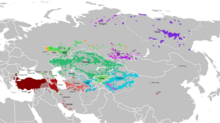

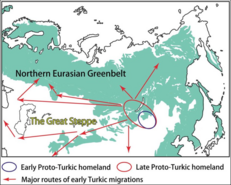




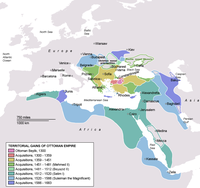
















![Ghaznavid portrait, Palace of Lashkari Bazar.[281]](https://upload.wikimedia.org/wikipedia/commons/thumb/b/be/Portrait_from_the_Palace_courtroom%2C_Lashkari_Bazar.jpg/92px-Portrait_from_the_Palace_courtroom%2C_Lashkari_Bazar.jpg)
